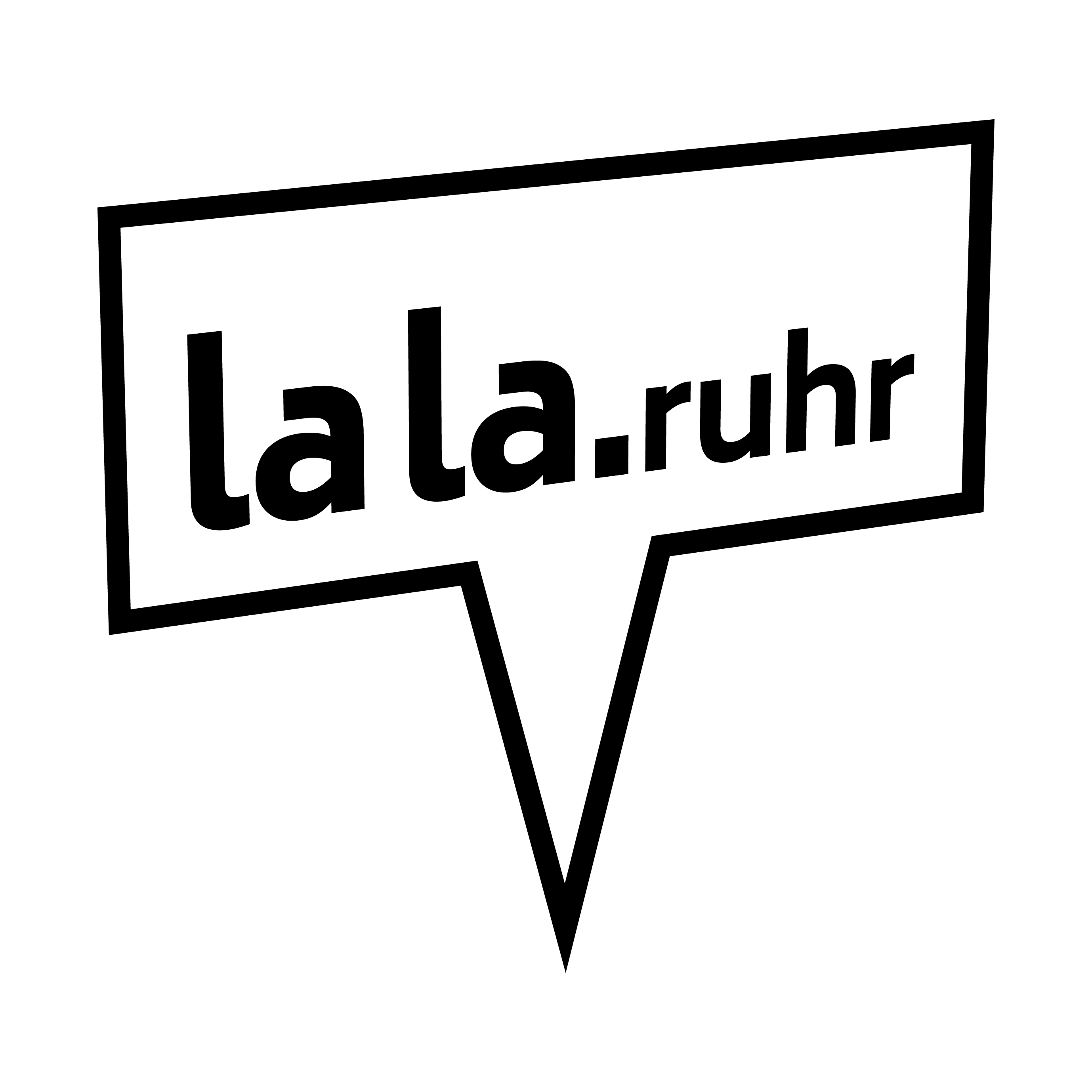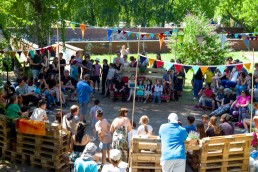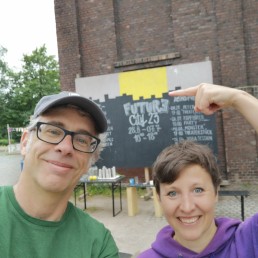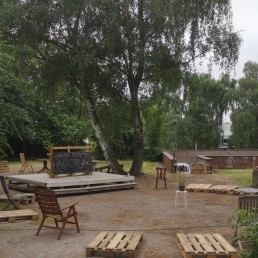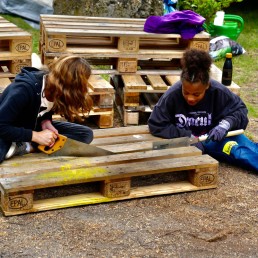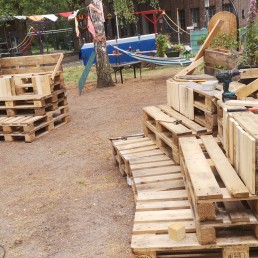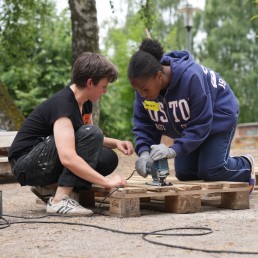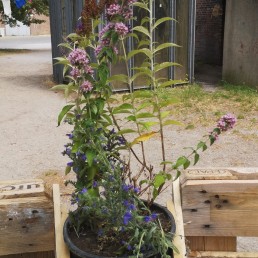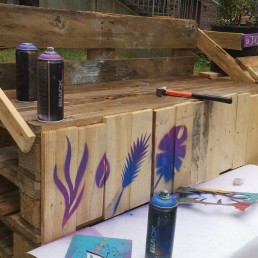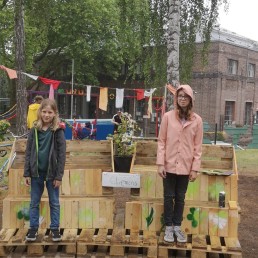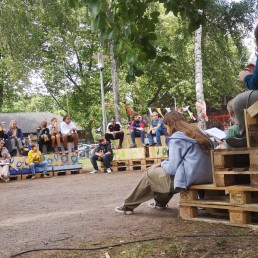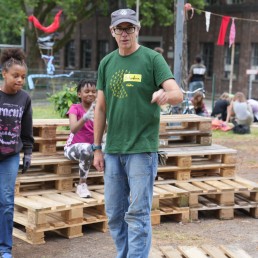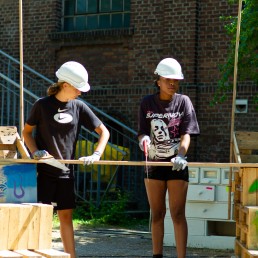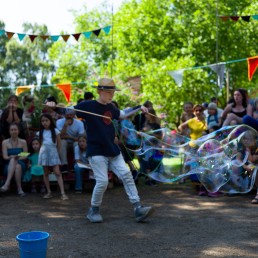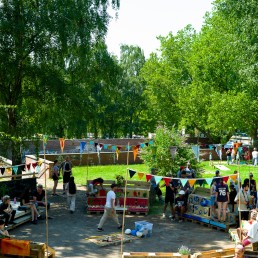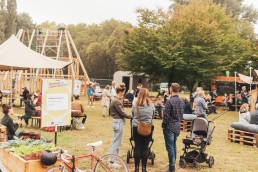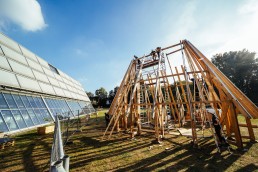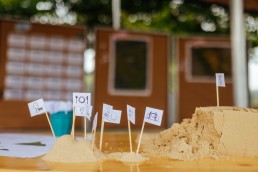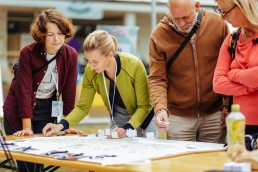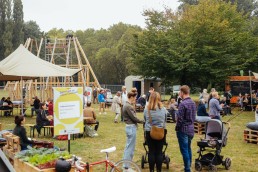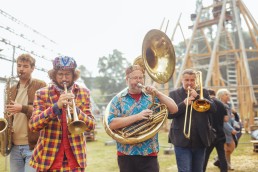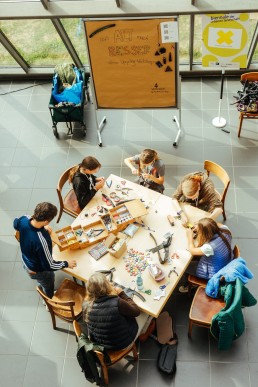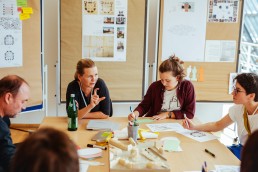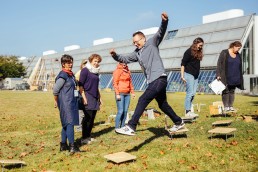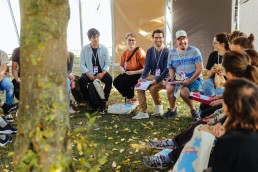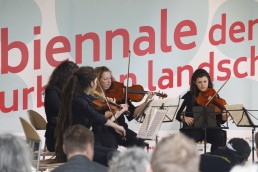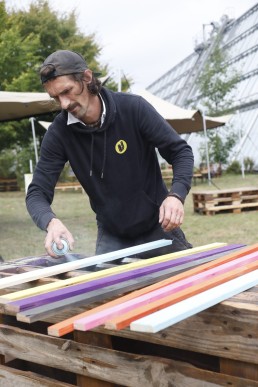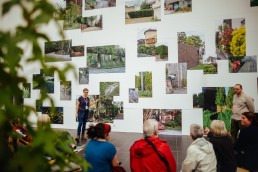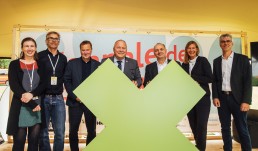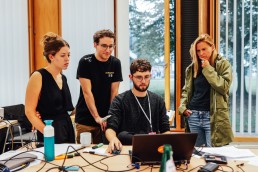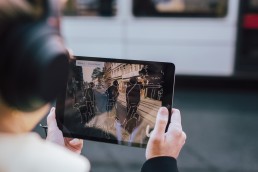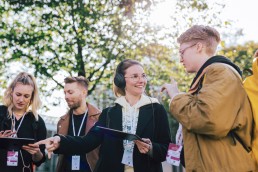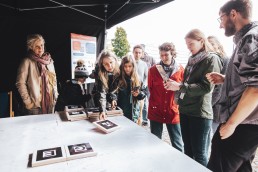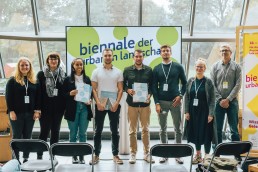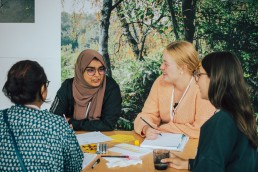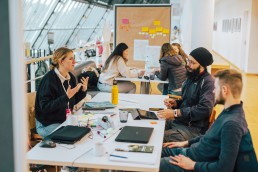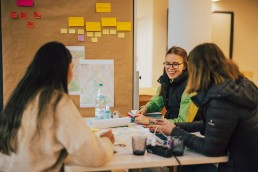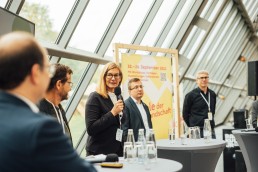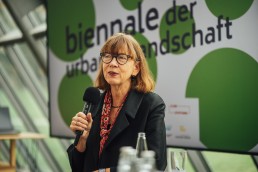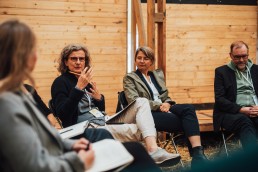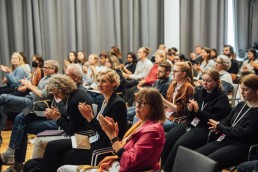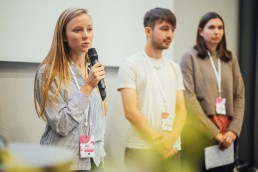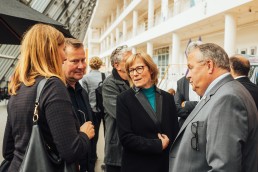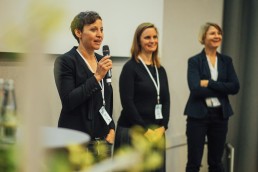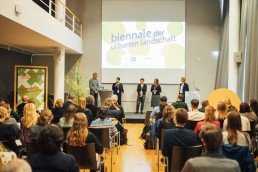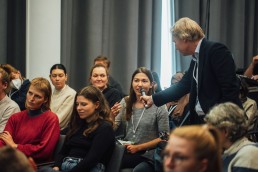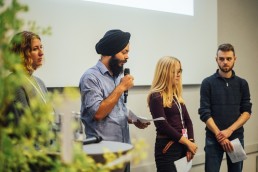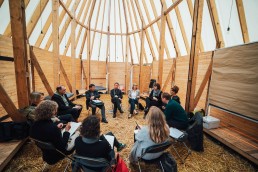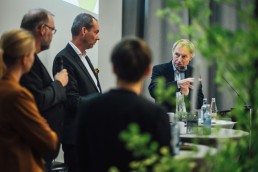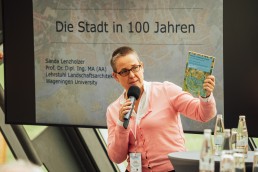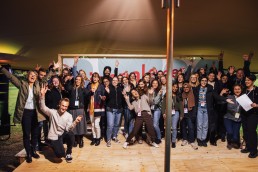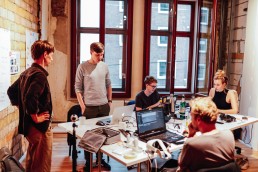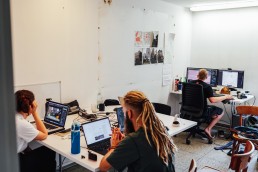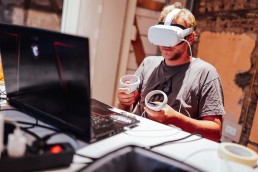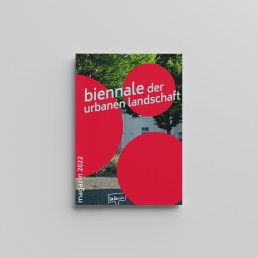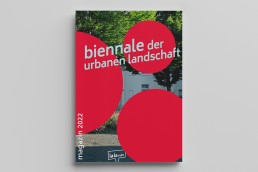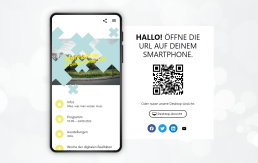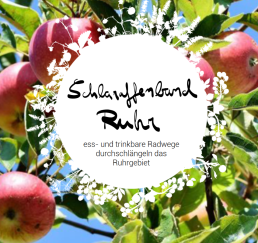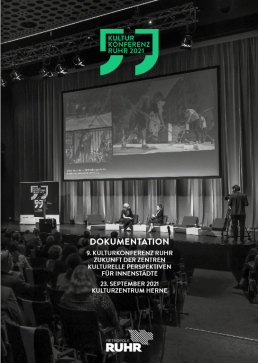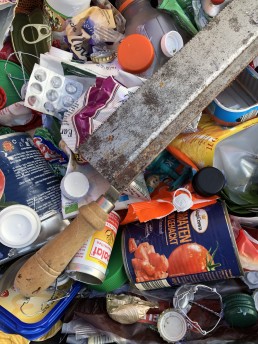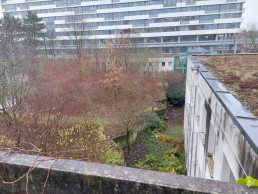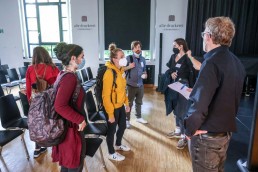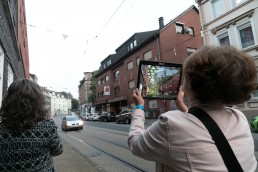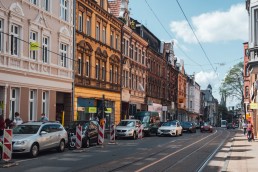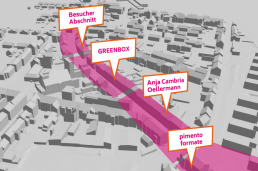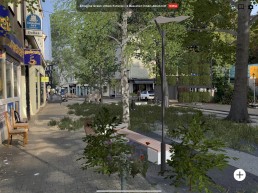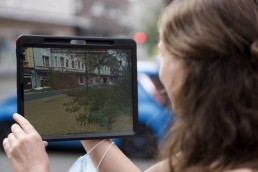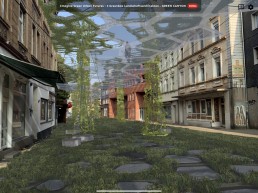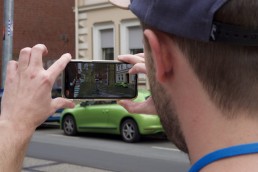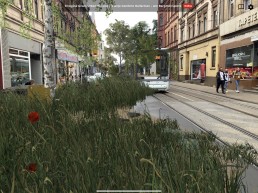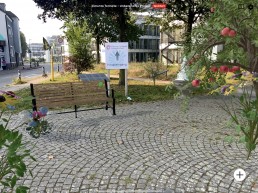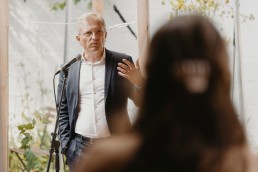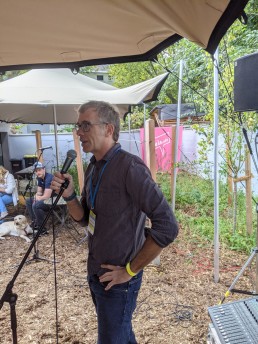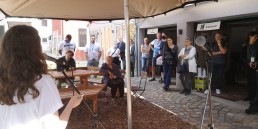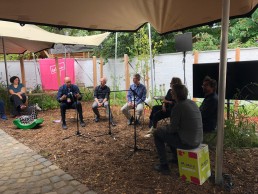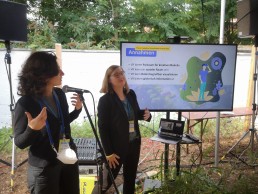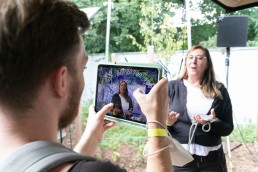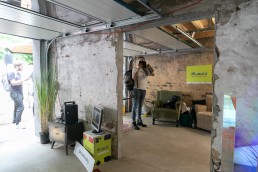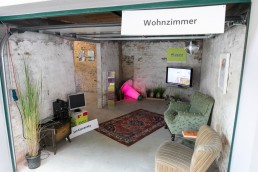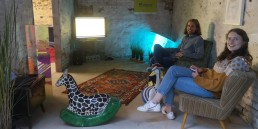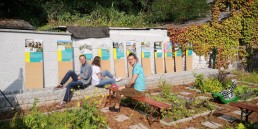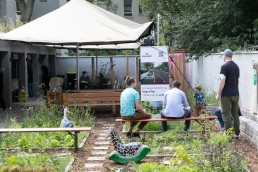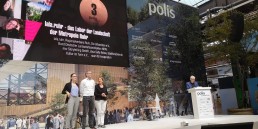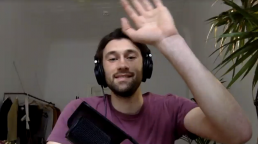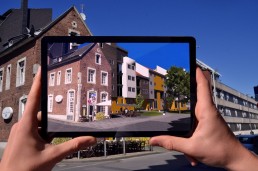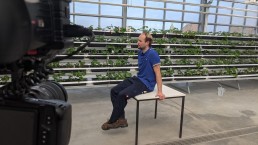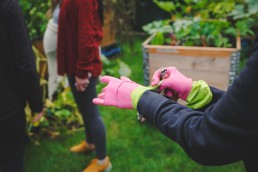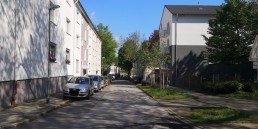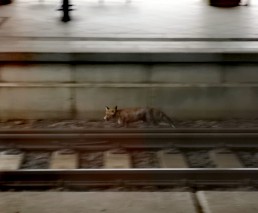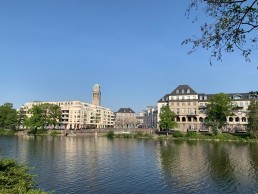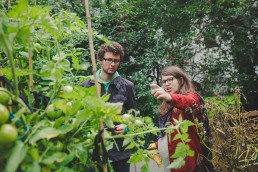An Agora for the Future City Festival 2023!
An Agora for the Future City!
Under the motto #BUILDINGFUTURETOGETHER, lots of different workshops for children and young people took place around the Maschinenhaus Essen as part of the third Future City Festival. For 14 days, people built, painted, sewed, danced, discussed, wrote poetry, and much more. And there was a lot of room to implement one’s own ideas and try out new things.
The festival is a project of the Theater of the Coming Generations. With the support of the Junior Uni Essen, Sebastian Schlecht and Susanne Priebs conceived and carried out a workshop for lala.ruhr at the Future City Festival by building an agora as the central place of the Future City.
Important for a city is a place of gathering, debate, exchange, presentation of ideas, music, dance, poetry, and very concretely for the parliament of the Future City. 10 children and young people built this place themselves in 4 days. From old pallets and scrap wood, an agora for the city of the future was created. An agora? A parliament? A stage? A theater? An arena? This place is all of that together!
Our agora also has a stage, but essentially forms a circle of three-tiered seating bleachers that can accommodate about 60 people. There are several entrances and the circle opens in all directions. This allows for participation or egress at any time. The stage can be used as a scene space or as a seating area to close the circle – an arena is created. The participants sit opposite each other, which creates a communication among themselves. Deliberately, there are also plants on the stage in order to draw attention to the role of nature in a city in addition to the diversity of the human participants. Thus, represented by 5 plant parliamentarians, other living beings should also get their place in the Future City.
The participants created their own place, where questions about the temporary Future City were decided during the festival. In addition, very concrete skills were learned and applied in the four-day workshop: sawing, screwing, nailing and designing – and discussing and deciding together. 10 young people between the ages of 10 and 14 used their own skills and old wooden pallettes to build a parliament for the 60 citizens of the city, selected plants, gave them a place and the stands a name and an identity. Self-made poles and flags connect the stands to each other and form another symbol of diversity and community.
We are looking forward to the Junior-Uni Essen and the Maschinenhaus Essen using this place for further actions!
Susanne Priebs and Sebastian Schlecht, August 2023
Photos: Young-Soo Chang, Alia, Sebastian Schlecht, Maschienenhaus Essen, lala.ruhr
Sieh dir diesen Beitrag auf Instagram an
Ein Beitrag geteilt von Maschinenhaus Essen (@maschinenhausessen)
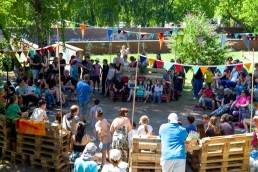
An agora? A parliament? A theater? An arena? A stage? A place for all! (c) Young-Soo Chang
biennale 2022 - review of a successful debut
Biennale 2022
- Review of a successful debut
From September 10-24, 2022, the first Biennale of the Urban Landscape attracted grassroots initiatives as much as the big players in planning. lala.ruhr invited motivated people from all disciplines to the festival. 204 contributors jointly offered more than 130 events in and around the Science Park in Gelsenkirchen.
The program and the results of this eventful and intensive 1st Biennale of Urban Landscape in the Metropole Ruhr can now be found with videos, photos and reports on the Biennale website.
Thanks to all who were there, who planned, discussed, built, promoted and celebrated. We could only do that together!
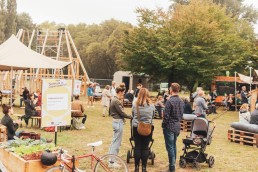
biennale of urban landscape: future needs building culture
Future needs
building culture
Baukultur NRW was involved in the first Biennale of the Urban Landscape with a wide range of program items: discussions and workshops, exhibitions, a Baukultur garden, international cooperations and the temporary urban development pavilion “a-circus”. Graduates of the Kunstakademie Düsseldorf had erected this pavilion on the grounds of the Wissenschaftspark Gelsenkirchen during the course of the festival. At the Biennale, the “a-circus” pavilion clearly symbolized the transformative forces of the urban landscape. In the sense of its temporary nature, “a-circus” travels, always pitching its tent in a new environment, revealing a fantastic world there for a short time – and later moving on. It is a concrete place – albeit temporary – that became an exhibition space, a forum for dialogue as well as a laboratory for sustainable urban development at the Biennale.
Understanding green cities
A city consists not only of houses, but also of the diverse life in between. How do you plan and build for that? A just, livable and sustainable urban landscape is a question of design and thus an important concern of building culture. Addressing the issues involved is relevant to the future. In order for a green future to grow, the Baukultur garden became a symbol and a statement for (green) building culture in the context of the Biennale. Green in the city can achieve many things, and important for this is an active engagement with nature. Only through this can a common understanding of a green, just and livable city emerge. Baukultur NRW had built and planted the raised beds in a cooperation with Grünlabor Hugo; they stood for exchange and urban production at the Biennale. Herbs, salads and vegetables grew there and provided a framework for the current Baukultur debate around the green city.
In cooperation with the Royal Danish Embassy, Baukultur NRW also presented the exhibition “Liveable City” for the first time in Germany, which was developed in collaboration with the Danish Institute for Urban Planning. The exhibition presents 28 successful examples of architecture and urban planning from Denmark, deliberately taking a look at projects outside the largest cities.
Is the urban green becoming a care case?
Baukultur NRW also took a multifaceted look at the green and just city in the other program. In cooperation with Kubia e.V. and the Copenhagen-based architects Dominique & Serena, a workshop focused on the inclusive design of urban spaces and infrastructures for every generation.
In order for green to come into the city, it must be thought about at the very beginning of any project – before planning begins: in Phase 0 of urban design. Baukultur NRW also invited visitors to the “a-circus” pavilion to discuss this issue. On other days, the focus was on the health of city dwellers from the point of view of “The green in care” as well as from the perspective of nature: “Is the city green becoming a case of care?” In urban planning, trade-offs between costs and benefits are central elements, but what is the “benefit” of greenery in the city, what is its cost? Especially under the impact of climate change, these questions came further into the focus of the discussion.
Excursions to the green region
The “Baukultur vernetzt auf Tour” format of the Baukultur-Akteur:innen network made a stop in Gelsenkirchen during the Biennale and was dedicated to the landscape of the Metropole Ruhr. Participants explored the region with Urbane Künste Ruhr, photographer Tania Reinicke and Forststation NRW and focused on disused industrial plants, places of the future, green backyards and works of art along the Emscher and in former churches.
This biennial was about nothing less than “the question of how we can not only preserve the Ruhr region as lovable, but also shape it as a region worth living in,” formulated Peter Köddermann, Managing Director Program of Baukultur NRW
For a long time now, the greenery of our cities has no longer been just a pleasant accessory, but an essential component of urban spaces designed to be sustainable, healthy and climate-friendly. Baukultur NRW would like to encourage people to think about the design of urban spaces and the integration of the important functions of greenery and to negotiate these in concrete terms. Actors in planning, citizens and other stakeholders and interested parties must work together to develop sustainable urban spaces as places to live. With reference to the current climatic developments in the cities, the question of a new approach to green and green planning in the region also arises in building culture.
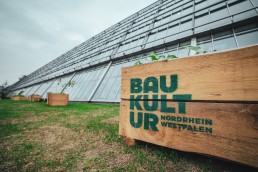
Baukultur NRW was involved in the first Biennale of the Urban Landscape with a variety of program items and encouraged people to think about the design of urban spaces and the integration of the important functions of greenery.
biennale of urban landscape: a weekend of diversity
A weekend
of diversity
Biennale of the urban landscape unites the motivated of all disciplines: mor than 200 actors, from the grassroots initiative to the big players of the Metropole Ruhr design over 130 events from 10-24.9.2022 at the Science Park Gelsenkirchen. We kicked off a successful opening with the “Weekend of Diversity”!
Whoever says "green" must also say "colorful"
Voices on the opening on 10/11.9.2022
“Classical music can rock,” commented Anna Betzl-Reitmeier, artistic director of the Ensemble Ruhr, on the performance by her colleagues – and that’s exactly what the 120 or so guests at the opening of the 1st Biennale of the Urban Landscape experienced firsthand. Furiously and with verve, a sextet of the Ensemble Ruhr introduced the Biennale with Tchaikovsky, which will take place from September 10 to 24, 2022 at the Science Park in Gelsenkirchen. The musicians in this rather unconventional setting for chamber music set the lively tone of the weekend, which remained palpable throughout the events.
During these biennial weeks, more than 180 actors will launch joint actions, present best practice examples and engage in lively discussions with experts and interested members of the public.
Many of them were active on this first “Diversity Weekend”. The rainy weather on Saturday did not dampen the participation in workshops, lectures, discussions and hands-on activities. On Sunday, in bright sunshine, further excursions, workshops and the jazz concert by the Brassholes Marching Band were very popular.
On the opening stage, moderated by the lala.ruhr initiators Sebastian Schlecht and Melanie Kemner, who also conceived the Biennale of the Urban Landscape, Gelsenkirchen’s city building councilor Christoph Heidenreich was pleased that the city of Gelsenkirchen was allowed to host the Biennale: “In view of climate change, we have to get away from silos. That’s no longer possible today, even in city government.”
Nina Frense, Deputy for Environment and Green Infrastructure at the Ruhr Regional Association, who succinctly summarized the transformation of the Ruhr region and its current challenges, also in a global context, added: “Our slag heap landscape exemplifies the transformation of our region through green infrastructure. Created as a waste product of mining, the slagheaps can now become drivers of the energy transition, as sites for renewable energies and as a prime example of how recreation, nature conservation, wind power and photovoltaics can work together in one place. For this, we need creative planners and the courage to break new ground, as we did here at the Biennial of the Urban Landscape.”
The regional power was clearly felt this weekend. The regional, supraregional and also international powerhouse of grassroots initiatives, planners, scientists and artists presented the incredible diversity of commitment to the green city of the future, as well as the activities around the Charter and Strategy Green Infrastructure of the Ruhr Regional Association, which sponsored this first weekend of diversity.
This biennial is about nothing less than “the question of how we can not only preserve the Ruhr region as lovable, but also shape it as a livable region,” Peter Köddermann, Managing Director Program of Baukultur NRW, formulated at the opening… And so, with great seriousness and openness, in the casual flair of the outdoor area and in the arcades of the Science Park, people debated and discussed together, built and experimented, exchanged ideas and looked for solutions to obstacles in implementation. What was special about this was that the unusual setting and the deliberately open formats created such an inviting atmosphere that the exchange between representatives of completely different disciplines and interested parties from outside the field was extremely relaxed and inspiring.
More than 50 program points from the solar roof check to the nature experience area for children, from the field on the parking garage roof to the slag heap excursion, from the upcycling workshop to the university research on the energy turnaround in Germany attracted interested and motivated people from all disciplines on this weekend. Planners and landscape architects, environmental educators and administrative staff, scientists and city makers, but also guests from near and far found their way to the festival meadow with its beach chair made of pallets and straw-filled cushions. They were all united by the desire to learn more about what is most pressing for all of us: how we can make our cities more resilient and climate-adapted as quickly as possible. The bottom line is that there is no shortage of ideas and concrete solutions, but in some places there is a lack of implementation.
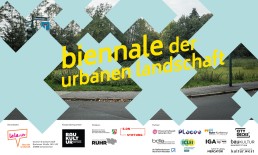
the 1st biennale of urban landscape sets new standards
The 1st Biennale of
Urban Landscape
sets new standards
For two weeks, the first Biennale of the Urban Landscape attracted grassroots initiatives as much as the big players in planning. The initiative lala.ruhr had invited motivated people from all disciplines to this biennial festival. 204 contributors played together in over 130 events in and around the Science Park in Gelsenkirchen.
The opening of the Biennale of the Urban Landscape brought back memories for many participants. The invitation to the Science Park in Gelsenkirchen marked the start of the event at the very place where the IBA Emscher Park began its work more than 30 years ago. Back then, it was the start of a new era. The first biennial succeeded in doing the same: It brought together more than 200 participants and enabled encounters, discussions and actions. The participants included makers of neighborhood projects as well as executives of the IGA 2027; young students as well as state secretaries and scientists. Many of these committed people have few points of contact with each other in everyday life. Unfortunately, because they all have in common that they are committed to the future of the urban landscape in the Metropole Ruhr.
The Science Park as the center of the Biennale
The Science Park Gelsenkirchen was the center of the Biennale for more than two weeks and thus the place of activity of the most diverse actors. The fact that many events took place outside in the park was no coincidence, but rather a symbol. For the focus of the Biennale was the landscape. The initiative lala.ruhr – the laboratory for the landscape of the Ruhr metropolis had invited people to discuss the urban future. In various calls it had called “into the urban forest” and received a huge response from committed people and makers. They all came with creative, scientific, artistic and, above all, hands-on ideas and projects. They created over 130 events, all of which took place in and around the Science Park between September 10 and 24, 2022.
Diversity weekend kicks off
The opening weekend was already marked by change. For the Biennale was about nothing less than the question of “how we can shape the Ruhr as a livable region,” as Peter Köddermann of Baukultur NRW said. This big question stimulated numerous debates, which were conducted with seriousness and openness, with visionary power and a sense of reality. Both in the park and in the arcades of the Science Park, people spent a weekend building and experimenting, discussing strategies and looking for causes of problems and obstacles to further development. The rainy weather on Saturday did not dampen the participation in workshops, lectures, discussions and hands-on activities. The sunny Sunday was ideal for excursions, workshops and the jazz concert of the Brassholes Marching Band, a cooperation with the New Colours Festival.
Excursion into the digital
In the second week, there was a lot of input and output on the ideal interplay between digital and urban design. The focus was on how digital technologies can help develop a sustainable city. A total of 20 young professionals and students from across Europe – including the Netherlands, the UK, Slovenia and France – worked together as part of a “hackathon in residence.” Their expertise ranged from 3D animation, game design, photography and VR programming to urban planning, landscape architecture and data analysis. In four teams, they designed ideas for sustainable developments in urban space. And that was just around the corner. The residencies dealt with problematic places and areas in Gelsenkirchen-Ückendorf concretely and directly on the doorstep of the Science Park. Brownfields, heat islands and street canyons like those in other cities were waiting for their digital transformation.
Visions of students
Young international representatives of planning and design disciplines also came together at the Biennale. The motto “Design for Urban Uncertainties” challenged the interdisciplinary working groups with students from TU Dortmund, TH Ostwestfalen-Lippe and RWTH Aachen University. While some teams worked on the open task on site in Gelsenkirchen-Ückendorf and designed concrete ideas for improving the district, other works remained at a higher altitude. They took a look at the entire Metropole Ruhr and sketched out scenarios of how the former industrial region can become an energy region. The range of ideas, visions and contributions was huge. They were all relevant; they all made it clear on how many levels there is a need for action.
Eine Convention zum Abschluss
Das letzte Wochenende der Biennale stand im Zeichen einer Convention zur urbanen Zukunft. Auch hier kamen zahlreiche Akteur:innen aus verschiedenen Kontexten zusammen und die Impulse, Fragestellungen und Diskussionen waren breit gefächert. Sie reichten von den Ideen der Studierenden, Natur basierten Lösungen für Städte über mangelnde Budgets in der Pflege von Grünflächen bis zum riesigen CO2-Verbrauch in der Bauindustrie; von der Wertschätzung für existierende Pläne bis zur Frustration über Hindernisse, von der Aktivierung kreativer, bottom-up-Potenziale bis zur Skepsis gegenüber Experimenten. Trotz der großen Bandbreite von Sichtweisen machte die Convention der Biennale der urbanen Landschaft deutlich, dass enormer Handlungsdruck besteht. Alle waren sich einig, dass aktuelle Krisen und der fortschreitende Klimawandel die urbane Lebenswelt bedrohen. Deshalb appellierte Anja Bierwirth vom Wuppertal Institut auch schnell zu handeln: „Je mehr wir trödeln, umso schneller kommt der Klimawandel auf uns zu“. Dass es „an programmatischen Ansätzen für Veränderungen“ nicht fehlt, machte Markus Lehrmann als Geschäftsführer der Architektenkammer NRW deutlich. Vielmehr stockt es vielerorts an der Umsetzung. Dass sich das nun ändern würde, stellte Nina Frense vom Regionalverband Ruhr in Aussicht. Sie berichtete, dass die „Charta für Grüne Infrastruktur“ im Ruhrparlament einstimmig verabschiedet worden sei und damit eine neue Verbindlichkeit entstünde. Der langjährige Begleiter der Region, Michael Schwarze-Rodrian, ging einen Schritt weiter. Er blickte auf die IBA Emscher Park und regte an: „Vielleicht brauchen wir wieder einen Werkstattcharakter, also die Offenheit für neue Herangehensweisen, den Mut zum Experimentieren und auch Fehler zu machen.“
Den Abschluss bildete ein „Blick zurück nach vorn” über die Bedeutung regionaler Formate für die Metropole Ruhr und ein Ausblick auf die Zukunft urbaner Landschaften für lebenswerte Städte – auch in 100 Jahren. Prof. Christa Reicher resümierte: „Das Ruhrgebiet hat schon einige regionale Formate erfolgreich umgesetzt. Die Biennale der urbanen Landschaft ist das richtige Format, um wichtige neue Perspektiven zu entwickeln.”
Outlook for next biennials
At the end of two intense and exciting weeks, Sebastian Schlecht, initiator of lala.ruhr, was very satisfied. “We succeeded in discussing very serious topics with fun and many committed people. That is an important concern for us. In this context, this first Biennale of the urban landscape was the prelude,” adds Sebastian Schlecht. The Biennale is conceived as a process and a first and successful kick-off has been achieved. He looks forward to 2024 with great pleasure and invites everyone to help shape the next biennial and, above all, the future of this region.
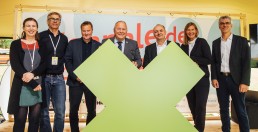
Urban landscape as a community task
Designing a region as a resilient and livable urban landscape is not easy. The 1st Biennale made that clear. But above all, it also showed that this cannot be achieved in isolation. The Biennale not only pleaded for cooperation, it lived it. For the event was only possible thanks to the support of Baukultur NRW, the Ministry for the Environment, Nature Conservation and Transport of the State of North Rhine-Westphalia, the Ruhr Regional Association and the E.ON Foundation. With their support, they all made this great and innovative festival possible. The Science Park Gelsenkirchen was both partner and event center.
Many other people, companies and institutions contributed to the Biennale. These include the Chamber of Architects of North Rhine-Westphalia, the Federal Foundation for Building Culture, the IGA Metropole Ruhr 2027, the Association of German Landscape Architects, City Decks, the Urbanists, Architects for Future, ICLEI Europe, Impact Factory, Jugend Architektur-Stadt, kultur.west, the Düsseldorf Art Academy, the Royal Danish Embassy Berlin, Places _ VR Festival, the Ruhr Conference, RWTH Aachen University, Salon5, Stiftung Mercator, the Technical University of East Westphalia-Lippe and TU Dortmund, the Urban League.
Press material with videos, photos, logos and graphics
Fotos: lala.ruhr/Ole-Kristian Heyer bzw. lala.ruhr/Ravi Sejk Videos: Jerome Chauvistré
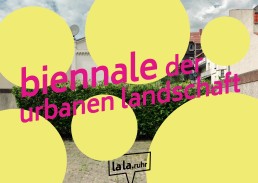
biennale and as well a convention
Biennale
may also
convention
On the last weekend of the 1st Biennale of the Urban Landscape, numerous experts brought important impulses into the discussion about the future of the Metropole Ruhr. The Biennale had invited to a convention at the end. As conventional as the format may sound, the content was equally stirring.
At the start of the convention, Sebastian Schlecht announced that serious topics would be discussed with fun at the Biennale. This even succeeded at the convention at the end of the two-week event. In many different rounds, numerous topics came to the table: from climate change and its threat to the urban landscape, from the variety of existing ideas for the Metropole Ruhr and the obstacles in implementing them, from committed people in the city being shot down with “that won’t work” to the call for a workshop that is open to experimentation and allows mistakes.
Student visions
The convention kicked off with the presentation of student work. In a total of eight groups, students from RWTH Aachen, TU Dortmund and TH Ost-Westfalen-Lippe had worked together for a week at the Biennale. In mixed-discipline teams, prospective spatial planners, urban planners and landscape architects sought solutions for “Urban Uncertainties”.
With this open task, they set out to find approaches for maintaining the quality of life in the Metropole Ruhr. While some groups focused on a conceptual scale and took the particularities of the polycentric region into a new future, others remained more concrete. They made proposals for the immediate surroundings of the biennial venue. They designed pocket parks for Gelsenkirchen-Ückendorf or upgraded the public space to make it a healthy and educational living environment for children. After all, “Children of today […] are adults of tomorrow.” Another group looked for the digital path and designed an app that improves communication between citizens and city administrations. Another team drew not only an ideal image of the city, but also a gloomy scenario; an exhortation to everyone to take the current challenges really seriously.
The future needs joint action
The seriousness of the upcoming crises and the current pressure to act were also pointed out by experts in a panel discussion. Markus Lehrmann, Managing Director of the North Rhine-Westphalia Chamber of Architects, made a stirring statement: “Climate change is nothing new, that is the worst realization. We’ve known about it for 40 to 50 years and we’re not changing anything.”
And the important role that landscape architecture plays in dealing with the current challenges was made clear by Thomas Dietrich as chairman of the BDLA NRW, who praised the Biennale. He said it directed attention to greenery, “which is relevant in all areas. It comes up in all fields of action: in climate adaptation, in creating social justice, in dealing with demography.” But in the Maintenance Case Green workshop, he also made clear that green can only be a solution to problems in urban areas if it is also maintained. And that is a problem, as Melanie Ihlenfeld from Grün und Gruga Essen described: “We are only fulfilling our duty to maintain the traffic; nothing more. That’s what the green spaces look like. Green has degenerated into a compulsory task”. The co-discussants agreed that the financing of care must be redesigned, which requires a constitutional redesign. Markus Lehrmann also turned his gaze to politics. In his opinion, “no one […] is bereft of ideas and programmatic approaches are there, but they have to get through to politicians and legislators.” Finally, Susanne Priebs from TU Dortmund University appealed again: “We need new discourses on the city, like Architects for Future and lala.ruhr are initiating” – in other words, praise for the first Biennale of the Urban Landscape.
We must dare more
Anja Bierwirth from the Wuppertal Institute also made it clear in her keynote speech where action is needed. Her focus was initially on the construction and building sector. Savings could be made everywhere, but not in this area. People still use many square meters per capita for living. But the single-family house is not always a dream, in some cases it becomes a burden. Non-residential buildings also hold potential, Bierwirth explains. We have to clarify how many of them we really use and simplify their conversion. Anja Bierwirth also did not omit to look at public street space and how it is shaped by traffic. She took a critical look at subsidies and appealed to abolish those that are detrimental to sustainable urban development.
At the end of her input, the representative of the Wuppertal Institute demanded that “working methods and processes be accelerated. Everything has to become faster, simpler, more efficient.” In this context, Stephanie Haury from BBSR even dared to demand: “Give money to the municipalities and dissolve the madness of funding structures.” Simplifications are also needed to take the contributions of civic initiatives seriously and value them: “They come to the administration and then it falters. Two- to five-year processes are the death of initiatives.” At the end of the discussion, many agreed: We need more room for experimentation and the courage to make mistakes.
Looking ahead
Christa Reicher from RWTH Aachen University started the last day of the convention with a look at the special features of the region. It is actually the most sustainable model of development, but the Ruhr region consumes twice as much CO2 as the rest of NRW, she explained. She, too, sees an urgent need for action and calls for, “We have to continue such formats [as this biennial] even with shrinking resources. It is a stage for incentive and success, to combine participation processes with top-down strategies.” But she also asks, “How do we need to network to create a creative laboratory?” Other co-discussants wished the same. For example, Mocki Diller from the Ruhr Conference said, “We need openness to other developments […]. We have to allow the spontaneous, also allow bottom-up.” Andreas Giga, head of the future initiative Klima-Werk at the Emschergenossenschaft, also considers something similar to be important: “We must not remain in the subjunctive and always say ‘we would have to and should’ and then go our separate ways and nothing happens.” The representative of the Ruhrbanen Liga also reported similar frustrations: “It is difficult to be taken seriously in dialogue with the city. It takes a lot of effort to communicate to politicians and administrators that we want to be involved in active urban design.”
When asked what would be put in the suitcase for the journey into the future, Peter Köddermann of Baukultur NRW said that he would not fill it, “because we don’t know how to open it. We don’t have an analysis problem, but an implementation problem. There are framework conditions that we have to face, but our structures don’t fit in.” Nina Frense from the Ruhr Regional Association counters this with a positive outlook. With the recently adopted Charter for Green Infrastructure, the Ruhr Parliament has made a commitment “to make everything that is on the table binding.
Transformation in the Ruhr and elsewhere
The last session of the convention started with reports from Sanda Lenzholzer from Wageningen University and Carlo Becker from Berlin. Both looked at other regions and their approaches to urban transformation. In the discussion that followed, Viktor Haase, State Secretary in the Ministry for the Environment, Nature Conservation and Transport in North Rhine-Westphalia, also looked beyond his own nose. He referred to the catastrophes on the Ahr and Erft rivers, “they must make humble” and called for climate protection to be put first. “The crises are growing exponentially, so we need exponentially growing solutions.”
Finally, Daniela Rizzi, with her outside perspective, made it clear that there is no lack of committed people: “If there are people on the ground who feel like doing an event like this, the government should kiss their feet.” In addition, the researcher from Brazil, who came to the Ruhr region while she was still a student, reminded everyone what great, innovative images the region has already put into the world and supports all the committed people in the Metropole Ruhr: “You have everything in your hands to put it into the world.”
With this encouraging call, the 1st Biennale of the urban landscape came to an end. Sebastian Schlecht concluded by pointing out that it is conceived as a process. “We want to develop the biennial further. This was the starting signal, which should find a continuation in two years.”
The convention was sponsored by the Ministry of the Environment, Nature Conservation and Transport of the State of North Rhine-Westphalia.


biennale hackathon: rethinking urban landscape
Rethinking Urban Landscape
Over one week, the four teams competing for the “hackathon in residence” have grown together at breakneck speed. The portfolio of the 20 participants ranges from 3D animation, game design, photography, VR programming to urban planning, (landscape) architecture, data analysis, conception and project management. Smart and creative solutions for sustainable development in urban living space is the encompassing theme. The focus is on sustainable redesign of especially problematic areas in the context of climate change.
Four interdisciplinary teams, four different locations, seven days and probably seven nights: The tight implementation schedule is one of the biggest challenges for the creatives. Immediately after the teambuilding, the discussion moved to brainstorming. In the project rooms provided, colorful Post-Its and flip charts with structure charts and mind maps adorn the plan walls. Brownfields, heat islands and street canyons are ready for their digital transformation. What was already conceptually visible after two days reflects the multi-faceted skills and combined clout of the young professionals and students.
Ückendorf as a project location is unanimously perceived by the participants as inspiring and exciting. Representatives from Switzerland, Austria, the Netherlands and Great Britain, as well as Berlin, Cologne, Wanne-Eickel and Gelsenkirchen themselves appreciate the potential that this district reveals to them for creative free thinking. With the results from this hackathon and the prototypes and ideas developed from it, the Biennale of the Urban Landscape can be a multiplier for other cities in the Metropole Ruhr to tackle the tasks that every surrounding city has to face, planned in a future-oriented and intelligent way.
Hackathon results on show in Ückendorf
The final results were presented to a jury of four experts. The winning team will receive prize money of 2,500 euros. On Friday from 3 p.m. and Saturday from 1 p.m., the general public can also experience these project spots with the prototypes developed – independently or in guided tours. The starting point is the designated info point at the back of the science park.
At the four stations along Bochumer Straße, visitors can immerse themselves in the creative minds’ world of ideas with the help of VR glasses and sound accompaniment. At the same time, the digital journey can also be followed by outsiders on monitors. The project participants will be available for further exchange on site. And the supporting program in and around the Science Park is also well worth seeing. An overview of the many lectures, information booths and workshops can be found in the Biennale program at:
Fotos: Ravi Sejk / Medienmalocher
The Hackathon in Residence is supported by the E.ON Foundation as part of the biennale der urbanen landschaft.
In Kooperation mit:

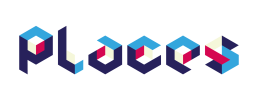
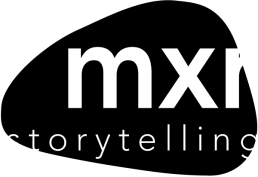
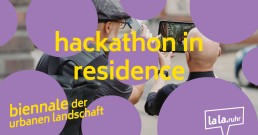
40 pages biennale - the magazine!
40 pages biennale -
the magazine!
For the 1st Biennale of the Urban Landscape, a 40-page magazine will be published that shows the colorful diversity of actors involved in shaping the “City of Tomorrow”. The magazine is available online now and in print at the festival.
The challenges posed by climate change to our cities and urban landscape can only be met if many people pull together. The voices of these “many” can be heard in this accompanying magazine. These are the local and international thought leaders who share innovative thoughts and insights from their work on the city of tomorrow. In sections such as “Portrait” and “Lab,” initiatives, actors, associations and best practice examples from the Ruhr region are presented. In the four-question mini-interview, the Biennale’s cooperation partners are asked about their views, while in the “Point of View” section, the content flies a little higher to put the Biennale’s themes in a broader context.
In addition, a glossary brings clarity to newer buzzwords and trendy buzzwords surrounding urban landscape. Figures, data, facts shed light on the question “How green is the industrial region?” and a pinboard spotlights some of the many initiatives, companies and activities in the Metropole Ruhr that help shape the urban landscape every day. Photographs from the Mapping the City exhibition and a slam poetry text give a taste of how the urban landscape is reflected in words and images on an artistic level.
Also available in print at the Biennial of the Urban Landscape and at the lala.ruhr office!
Program launch for the 1st Biennial of the Urban Landscape
Program launch
for the 1st Biennial of the Urban Landscape
Program launch for the 1st Biennial of the Urban Landscape
Here it is, we have published the program for the 1st Biennial of Urban Landscape! The Biennial will take place from September 10-24, 2022 and will include three intensive weekends and two active working weeks. All events are free of charge. You can find the program in our Biennale app lala.ruhr/biennale-programm. Here you can also register for events with a limited number of participants.
About the Biennale app
With the web app of lala.ruhr all information, programs and actors are directly available without download and installation. The app is optimized for smartphones, but works on any device. Practical: Users can mark interesting program points and thus compile their own biennial program. Current program information is communicated here and participants can chat and network with each other.
The central question is how we can make our cities resilient, livable and fit for the future.
September 10-11: Diversity Weekend
This is a meeting place for everyone who wants to actively work on the green future: interested people and experts, planners and administrators, scientists and city makers – motivated people from all disciplines. The content ranges from actions in the neighborhood to philosophical and political debates to concrete urban development and design of the green city of the future. There will be lots of workshops, lectures, presentations, panel discussions and excursions on “green infrastructure”, and building, screwing and gardening will be done together to create the festival center at the Science Park Gelsenkirchen.
September 12 – 17: Digital Realities Week
Digital is better? Not always – but digital technologies can help to develop a sustainable city in which its inhabitants live better. That’s why the “Week of Digital Realities” will feature both input and output on the ideal interplay between digital and urban design. In a week-long hackathon in residence, several teams will develop concrete solutions to real-world problems using VR, AR, Big Data and AI. In parallel, there will be a wide-ranging lecture program.
September 18: Field Trip Day
Expedition to the Ruhr region! With our cooperation partner Baukultur NRW and with Urbane Künste Ruhr we start a journey of discovery through the region on different paths.
September 19 – 24: Week of Visions
With the ideas of the students from the Campus Week (September 19 – 23) under the title “Design for urban uncertainties”, an international weekend of competencies, frameworks, solutions and visions for a green regional future will start on Friday, September 23. Green strategies and real-world solutions will be discussed from global and local perspectives. Experts will look back on the past successes and visions of the Ruhr region, discuss the current projects of the Ruhr-Conference and conclude by talking about the landscape as a basis for an urban and regional future – because it starts now.
24 .September: Closing ceremony with green picnic
The end of the Biennale is the beginning of the future. What could be better than celebrating and enjoying this departure together?
Baukultur North Rhine-Westphalia
As a cooperation partner of the Biennale of the Urban Landscape, Baukultur NRW is contributing its own curated program section with current building culture topics in a total of 16 event formats to the Biennale program. The venue is the pavilion “a circus”, a project of the Baukunstklasse of the Art Academy Düsseldorf, which has found its place on the Biennale site Wissenschaftspark Gelsenkirchen. A arena that is open to actors, partners and players as a meeting place for further thinking about the “green city”. Baukultur NRW understands itself as an actor in the center of the thematic diversity of the Biennale and connects the current questions, tasks and expectations of building culture with the green and livable urban region in climate change.
You can access our Biennale app at: lala.ruhr/biennale-progamm
BIENNALE 2022 - Hackathon in Residence
Call:
Hackathon
in Residence
*CALL CLOSED* We are looking for curious and open-minded people from different disciplines. Whether you are a landscape architect, architect or urban planner, game designer, programmer, maker, specialist in geodata and LoRaWan sensors, or you are interested in XR, VR, digital art and other interfaces between digitality and the reality of the city.
As part of the first Biennale of urban Landscape, we are organising a “Hackathon in Residence”. From 11.09 – 18.09.2022, we invite people from different disciplines (architecture/planning, IT/digital, art/creative economy) to Gelsenkirchen-Ückendorf. Along the Bochumer Straße, 5 public places will be “worked on” by the teams. We offer expense allowance, accommodation, food and the chance to win prize money.
Live and work for a week in one of the most exciting urban quarters of the Ruhr area. Work in an interdisciplinary team on a challenge for the green city of the future. Present yourself and your ideas to the public.
We want to find out how digital technologies can help us design better, greener and more people-friendly cities.
Application deadline is 15.07.
All information in the Info-PDF:
The Hackathon in Residence project and the biennial of urban landscape sponsored by the E.ON Foundation
In cooperation:



The Hackathon in Residence project and the biennial of urban landscape sponsored by the E.ON Foundation

In cooperation:



The first Biennial of Urban Landscape!
OPEN CALL!

The first Biennial of Urban Landscape!
It’s official: From 10-24 September 2022 lala.ruhr is organising their first Biennial of Urban Landscape – an international festival on the green city of the future!
Everyone is welcome to discuss and develop ideas and solutions at workshops, exhibitions and excursions. Join us in the heart of the Ruhr region, in the creative neighbourhood Gelsenkirchen Ückendorf.
Find out more on our new website: www.lala.ruhr/en/biennial
Want to keep updated? Follow us on Instagram or Linkedin and sign up for our newsletter!
STAY TUNED!
you want to know what's going on?
Join our newsletter list and we'll keep you up to date.
tasty ribbon ruhr: edible and drinkable cycle paths for the ruhr region
tasty ribbon ruhr:
edible and drinkable cycle paths for
the ruhr region
Sustainability is trendy. Especially in the wake of climate change, it is becoming increasingly important to implement long-term solutions. Here in the Ruhr region, too, there are many new ideas. lala.ruhr supports the new project of the food councils of the cities of Bochum, Dortmund and Essen and the initiative “Schwerte pflanzt”: With the “Schlaraffenband Ruhr”, edible wild plants are to be planted along the cycle paths Emscher-Weg, RuhrtalRadweg and the future cycle path Ruhr (RS1), snacking places are to be created and drinking fountains installed. In this way, easy access to sustainable and local food can be created and interesting knowledge about edible plants can be imparted at the same time.
The idea combines the attributes of eating, networking and sustainable in a fairytale way, so to speak: “We don’t have chicken flying into our mouths, but it can be nibbled and the path from plant to plate is very short.” (Quote from EssBO!)
Accordingly, the name was created in reference to the fictional, playful place “Schlaraffenland” from many earlier fairy tales. The chain ribbon stands for the cycle paths that link the region. The pearls form the individual nibbling places. In summary: the concept of a tangible sustainable, edible and drinkable Metropole Ruhr of the future present!
Green infrastructure is increasingly coming into focus in the Ruhr region: the numerous industrial areas are flourishing and the appreciation for nature in the city is increasing. The cycle paths (RS1), Emscher-Weg and RuhrtalRadweg connect the entire Metropole Ruhr from west to east over a distance of approx. 1200 km, thus creating environmentally friendly links between the cities. Edible wild plants such as blackberry, quince, raspberry, apple, thyme, borage and drinking water fountains are to be established along these cycle routes. Citizens can also take care of these urban nibbling oases themselves and make a contribution to the project and to nature in their surroundings; keyword: care through participation. Because: The sense for the origin and value of good food was lost more and more in the late 20th century and is to be strengthened again through this initiative. Environmental education is strengthened through information boards at the respective locations.
The conviction of the initiators: The implementation of the Schlaraffenband Ruhr will promote urban greenery, strengthen sustainable urban planning and transport, and create biodiversity and species diversity. The first pilot projects are to be implemented in the next few years. Until then, in addition to the numerous contributors, we are still looking for further supporters who are passionate about the topic and can identify with it.
So get in touch with:
EssBO!
Nutrition Council Bochum
c/o Griesenbruchstraße 9
44793 Bochum
essbo@ernaehrungsrat-bochum.de
www.ernaehrungsrat-bochum.de
Only with your support can the Schlaraffenband Ruhr continue to exist in the future and initiate other follow-up projects. Join in, eat, drink, cycle, care for your food and engage in lively exchange with your fellow human beings!
The concept of all participating actors can be downloaded here (in German): Schlaraffenband-Konzept-I06
Author: Stephanie Stiehm
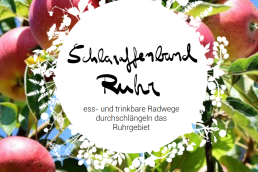
lala.ruhr supports the vision “Schlarrafenband Ruhr”.
Future of City Cetners: Documentation of Cultur-Conference Ruhr published!
cultural conference ruhr:
documentation published!
FUTURE OF THE CENTRES – CULTURAL PERSPECTIVES FOR INNER CITIES
This was the motto of the Cultural Conference 2021 as a format to which the Regionalverband Ruhr (RVR) and the state of NRW invite annually in order to offer the cultural scene a stage for regional and cultural-political as well as artistic discourse.
lala.ruhr was also there and explored the question from the perspective of the urban landscape in its own workshop: The future of centres is green, inclusive and productive.
The city centre of Herne as a “laboratory for the landscape”: The workshop explored the green potential of the urban space from different perspectives. The goal: to upgrade the city centre, with a special focus on open spaces and streets, towards a more liveable place. An upgrading of the city centre is by no means exclusively linked to the new construction or conversion of buildings. Outdoor spaces offer potential in many ways, making multifunctional use just as possible as temporary projects and a fundamental green urban development adapted to the consequences of climate change. Sebastian Schlecht of lala.ruhr: “If it’s not about money, but about the quality of the city centre, then a car park can be more than an asphalt surface and a green space more than a mown lawn.” He said it was important to see such places as “opportunities” and to design and use them in a new or different way together with the people – “that has a lot to do with quality of life and a liveable inner city.”
takeover*: the concept of urban metabolism
takeover*:
the concept of urban metabolism
Everyone in the world produces waste: the banana peel as organic waste, the mobile phone battery as electronic waste, the cardboard box as waste paper or the plastic bag as a recycled product. Especially in times of the Corona pandemic, much more garbage/waste was produced in general, which, moreover, could often only be incinerated. The reason for this: Corona viruses potentially adhering to it.
In science, too, many research series are underway that deal with the avoidance of waste and the reuse of materials. Consequently, our cities have an “urban metabolism”, which refers to the transformation of materials and energy in a city.[1]
The term was coined by the German philosopher and economist Karl Marx, as early as 1844 in relation to environmental sociology. Marx made it clear that we humans are dependent on nature and damage it with our economic processes [2]. The basic concept of urban metabolism then goes back to the US engineer Abel Wolman in 1965, who for the first time considered the city as an ecosystem in its own right with its material and energy flows [3].
Since the 19th century, cities have become increasingly important because they were and are the engine of economic growth. Cities are an open system that consumes energy, fuels, raw materials, water, food and air. After these resources have been used, waste, pollutants or even waste water are produced, unless they are tied up in infrastructures. The larger a city becomes – whether with the expansion of its area or the increase in population – the higher the demand for resources/materials increases. Due to different factors, however, each city must be considered as an individual. Thus, in order to be able to determine the urban metabolism, the three most common methods are used: Material Flow Analysis, Ecological Footprint Adaptation and Life Cycle Assessment (see blog post on HeimatERBE). The focus is always on the inputs and outputs of a city and the resulting impact on humanity and the environment.
Solutions and realistic goals are needed to tackle the problems created in cities: more efficient use of local resources, use of recycling systems including waste prevention and management strategies, provision of clean air and recreational green spaces, reduction of greenhouse gas emissions and urban planning (climate) adaptation strategies. It also aims to end huge exports of waste abroad and use local recycling and closed-loop incinerators. New product designs help to make reusable materials more attractive.
In many places, projects on the topic of “waste” are already being set up in schools to raise awareness of “waste”. Whether it is picking up rubbish or learning how to separate it properly, everything has an effect on our environment. The data collected in this way can benefit science. Through comprehensive mapping, processes for waste avoidance or recycling can be improved.
For a global overview of the different urban metabolic processes, the “Metabolism of Cities” platform is a good place to start. Take a look, discover and accumulate knowledge. Another literature tip: The page of the format “Quarks und Co” on the topic of waste.
Text author: Stephanie Stiehm
lala.ruhr takes over the Instagram account of vier.ruhr, the alliance of Mülheim theatres, for three weeks with the takeover in January 2022. Our theme: the rubbish complex. We’ll take you on a digital journey through the region and beyond – to places where something is created from rubbish or where work is done with what we colloquially call it. We invite you to also think of the urban landscape of the Metropole Ruhr in a circular way and to discover all materials as part of cycles. We present the HeimatERBE company because, among other things, it takes care of the conversion of areas that were previously considered “useless” in the public perception and enables business enterprises to act in an environmentally neutral way.
vier.ruhr is the theatre alliance of Theater an der Ruhr, Mülheim Theatre Days “Stücke” and Ringlokschuppen Ruhr. Funded within the framework of NEUE WEGE by the Ministry of Culture and Science of the State of North Rhine-Westphalia in cooperation with the NRWKULTURsekretariat.
Sources:
[1] Oke, T. R.; Mills, G.; Christen, A.; Voogt, J. A. (2017): Urban climates. Cambridge. https://doi.org/10.1017/9781139016476
[2] Bleher, D.; Öko-Institut e.V.. (2017): Resource impact of urban metabolism Results of WP 1.1 within the UFOPLAN project FKZ: 3715 75 122 0. Darmstadt.
[3] Sanches, T. L.; Santos Bento, N. V. (2020): Urban Metabolism: A Tool to Accelerate the Transition to a Circular Economy. In: Filho, W. L.; Azul, A. M.; Brandli, L.; Özuyar, P. G.; Wall, T. (eds.): Sustainable Cities and Communities. 860-867. https://link.springer.com/referenceworkentry/10.1007%2F978-3-319-95717-3_117
Translated with www.DeepL.com/Translator (free version)
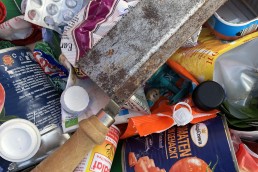
Everyone in the world produces waste: the banana peel as organic waste, the mobile phone battery as electronic waste, the cardboard box as waste paper or the plastic bag as a recycled product. Rubbish is part of the “urban metabolism”.
© Broy
takeover*: HeimatERBE - a conservation forge for the ruhr area
takeover*: home heritage
- a conservation forge
for the ruhr area
Holiday trips, exotic foods and things that end up in the corner immediately afterwards are part of our everyday consumer behaviour. This has a negative impact on our environment: important resources are consumed, habitats are degraded or destroyed and species extinction is on the rise. So how can the damage caused in this way be avoided and compensated for in order to achieve an ecological, environmentally sound way of life in the long term?
lala.ruhr cooperates with the Impact Factory, a start-up platform for social entrepreneurship, and has exchanged ideas here with the innovative Essen-based company HeimatERBE GmbH.
HeimatERBE GmbH was founded together with its sister company greenzero.me 2020 by Dr. Dirk Gratzel after he had made it his mission to record and compensate for all the environmental damage he had caused in his life. To this end, he was in contact with numerous scientists and was finally the first person to determine his complete life eco-balance and the resulting damage to the environment together with the TU Berlin and the TU Braunschweig – this corresponds to what greenzero.me does today. Together with other experts from the fields of forestry, ecology, biology and nature conservation, he then developed a strategy to compensate for the environmental damage – this is now the work of HeimatERBE GmbH. With the help of the two sister companies, business enterprises in the B2B model now have the opportunity to make their organisation, their service or their products environmentally neutral.
HeimatERBE now has seven employees in the fields of ecology, economy and technology. The urban and landscape ecologist Madlen Sprenger (M.Sc.) was a guest at lala.ruhr and told us about the idea behind HeimatERBE’s corporate principle. In the interview with our intern Stephanie Stiehm, the compensation of environmental damage and the HeimatERBE principle were discussed:
What exactly do you do at HeimatERBE? What is your mission?
The goal of HeimatERBE is to compensate for negative environmental impacts. To this end, we are currently restoring old industrial sites from the Ruhr region to as good an ecological condition as possible, in which they then provide (secondary) habitats for diverse plant and animal species. Natural as well as cultural landscape biotopes thus ensure the creation of new ecosystem services as well as the preservation and improvement of existing ones*. The creation of new biodiversity and the protection of the climate and people are the top priorities for HeimatERBE. HeimatERBE thus creates added value for nature and for society. They offer this added value to companies to compensate for their negative environmental impacts from services or products, for example.
*”Ecosystem services are the services provided by nature to humans through habitats and living organisms such as animals and plants. Ecosystem services provide the basis for basic human needs, such as access to water and food. Functioning ecosystems depend on an interplay of numerous organisms, such as primary producers (e.g. plants), herbivores, carnivores, destructors (decomposers), pollinators and pathogens. Biodiversity with all its levels is therefore considered the essential cornerstone of ecosystem services” [1].
What is the HeimatERBE principle? What components does it consist of?
The HeimatERBE principle describes the process that leads to achieving environmental neutrality. At the beginning of each project, the life cycle assessment of a person, organisation, product or service must be calculated. This analysis determines all environmental impacts from production to disposal, including the manufacture of consumer goods. (This balancing is standardised in DIN EN ISO 14040/44.) The results are then monetarised – i.e. converted into environmental costs according to the standard of the Federal Environment Agency. The environmental costs are a purely monetary amount which we receive from our life cycle assessor (e.g. greenzero.me). It describes the actual environmental impacts. This then results in the environmental value, which creates a balance between the environmental costs. The environmental value represents the amount of money needed to compensate for the harmful environmental impacts. What we have to spend financially for the production of efficient and functional ecosystems – i.e. the production costs up to “biotope maturity”, corresponds to the environmental value.
How can HeimatERBE then work with it?
Life cycle assessment and monetisation are of course always aimed at causing some damage. Of course, it is important to reduce this damage as much as possible in the process first. HeimatERBE only offers compensation for such processes that have already been optimised. What we then do is reinvest these identified environmental costs. The environmental value we create is the reflection of the environmental costs. This is the momentum where environmental neutrality is achieved because the costs are reinvested at this point in the process and the externalities are internalised. The customer has to pay one-to-one for the compensation of the environmental costs. By monitoring the development status, HeimatERBE can check whether the goals of its compensation measures, which we describe in a development plan beforehand, are being achieved. For HeimatERBE, the focus is on environmental neutrality. In addition to the greenhouse effect caused by the emission of climate-altering gases, components such as acidification, overfertilisation (eutrophication), ozone pollution on the ground (summer smog) and destruction of the (protective) ozone layer in the stratosphere are also included. Compensation strengthens the protected goods of biodiversity, climate and human health. The terms explained above, such as life cycle assessment, monetarisation, environmental value and ecological enhancement performance, are elementary components for achieving environmental neutrality.
What are your current projects and what are your next plans?
A current example is the former Ewald 5 shaft site in Herten. There, an old forge stands on the site as a very special feature. The area was still relatively heavily used as a construction site until August 2021. Today, calm has returned and we decided to convert the building into a “species protection forge” – we had already found traces of (previous) colonisation by a barn owl and bats, so the rededication was perfect. This means that the whole building is for species protection only. We have closed the building completely to humans and have only created entry points for animals, especially for bats and for birds that live in the building. In addition, we have created nesting aids and roosting structures on the façade and inside the building, which can be used as habitats for the animals. But there are also small entrances for ground-dwelling small mammals and co, which can also find shelter there. However, this building only makes up a small part of the 8 ha area. In other parts of the site, HeimatERBE will also carry out unsealing and deconstruction measures, remove rubbish, preserve and optimise existing biotopes (e.g. convert afforested stands into native forest communities or convert damp open land into extensive cultural landscape use) and create new habitat types or encourage/allow their development (e.g. fields with pioneer and spontaneous vegetation, flower-rich herbaceous borders, wild fruit stands).
Another very interesting site is the Kurl 3 area in Lünen. There, for example, goldenrod is relatively widespread and actually determines the whole character of the area. At first we thought it would probably make the most sense to remove the soil. But in contact with NABU from Unna, it turned out that various orchids were already present there. Now we are in the process of gently converting this area so that we can preserve the orchid populations.
A very special project, which far exceeds our previous work in complexity and scope, is currently underway in Duisburg-Ruhrort. Together with the Haniel company, we at HeimatERBE and greenzero.me have set ourselves the task of transforming the district into the world’s first environmentally neutral neighbourhood by 2029. There will be a lot of work to do with the city, local businesses, interest groups and, of course, the citizens of Ruhrort. It will be a challenging project that has great potential for the district, the whole city of Duisburg and the Ruhr region.
Further purchases of degraded and devastated areas, which do not necessarily have to be former industrial sites and in the Ruhr area, are planned in order to be able to meet the growing demand for holistic, multi-dimensional and local compensation, according to our previous working methods.
All further information about the current projects and much more can be found on the HeimatERBE website. There is also a film explaining further details.
* lala.ruhr takes over the Instagram account of vier.ruhr, the alliance of Mülheim theatres, for three weeks with the takeover in January 2022. Our theme: the rubbish complex. We’ll take you on a digital journey through the region and beyond – to places where something is created from rubbish or where work is done with what we colloquially call it. We invite you to also think of the urban landscape of the Metropole Ruhr in a circular way and to discover all materials as part of cycles. We present the HeimatERBE company because, among other things, it takes care of the conversion of areas that were previously considered “useless” in the public perception and enables business enterprises to act in an environmentally neutral way.
Author: Stephanie Stiehm
Sources:
[1] Umweltdachverband (n.d.): Ökosystemleistungen – von der Natur kostenlos erbracht https://www.umweltdachverband.at/themen/naturschutz/biodiversitaet/oekosystemleistungen/
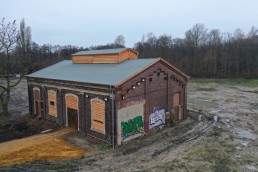
The “Species Protection Forge” at the Ewald 5 shaft site in Herten – one of HeimatERBE’s projects. © HeimatERBE
The role of urban biodiversity
The role
of urban
biodiversity
Biodiversity is one of the central issues of our time and also an important topic in the work of von lala.ruhr in an urban context. The contribution of urban nature to a livable environment not only promotes the quality of life of the human inhabitants of our cities. A high level of biodiversity enables our cities as green infrastructures to meet the demands of today’s world. For this reason, Stephanie Stiehm, an intern at lala.ruhr and a master’s student in geography with a specialization in urban and landscape ecology, has broken down the role biodiversity plays in our cities for our blog in this post.
The global population is growing – with more and more people living in urban areas, increasing the level of urbanization. By 2050, over 68% of people are expected to live in cities. Species extinction and the associated loss of biodiversity is also one of the great crises of our time. In the last 50 years, about 50% of all species have become extinct. What role do cities play in this? Our cities are also part of an interconnected ecosystem and thus also provide a good living environment for people.
The term biodiversity is generally divided into three levels: Genetic diversity, species diversity and habitat diversity. They are subject to constant temporal and spatial dynamics: “urban biodiversity” does not only encompass natural processes, but also includes deliberate anthropogenic (human) actions. Consequently, biodiversity in urban areas is not found, but also co-created by citizens [1]. Furthermore, regional biodiversity impact refers to the influence of human life in the city on the surrounding countryside. On the global scale, regional influences are then transferred to distant countries and their ecosystems.
But where exactly does biodiversity exist in the city? Urban wilderness includes pavement crevice vegetation, areas of free succession, or completely pristine areas [2]. Biodiversity is actually higher in cities compared to rural areas due to their many different habitats. These include urban forests, urban parks, open green spaces, watercourses and many other micro-biotopes.
The high occurrence of species in urban areas is explained by many areas in the city that can be left to natural succession as well as different stages of succession coexisting. Examples include railroad tracks, rooftops, houses, industrial sites, roadsides, and brownfields. The number of therophytes (annual plants) increases with the degree of urbanization. This is due to the structural richness of the urban habitat explained above, as well as the availability of a variety of food and habitat. In addition, animals may live under reducing competition with other conspecifics. A common feature of cities is the increased occurrence of neobiota. The term neobiota refers to all species that live in an area (in this case, the urban area) by being non-native [1].
First, the difference between rarity and endangerment must be noted. The term rarity includes the actual occurrence of species without human intervention. If organisms occur infrequently, they are classified as rare. The endangerment is to be described with a negative population development. The cause of this is often man, which is why we also speak of anthropogenic rarity. The “Red List” serves as a directory or overview table of the endangerment status of animals and plants and is used as a data source.
In North Rhine-Westphalia, 43,000 fungi, plants and animals exist [3]. Many of these creatures are endangered and are designated as species relevant to planning. Special attention must be paid to these species during construction projects and if their habitats are destroyed, replacement and compensation areas must be created.
Biodiversity is measured by means of biotope mapping (especially for plants) and counts of species groups or single individuals. In the process, values for population density are determined. In the end, species guidelines are often developed for the cities, whereby biodiversity can be increased in a targeted manner.
Activities in the Ruhr area
The Urban Biodiversity Network has existed in the Metropole Ruhr since 2012. It consists of numerous researchers and institutions of the Ruhr area, which deal with the topic of biodiversity and develop a strategy for the Metropole Ruhr. The aim is to develop measures that preserve and promote regional biodiversity. Since mid-2020, the “Regional Biodiversity Strategy Ruhr Area” has been funded by the state government. It is a sub-project of the “Green Infrastructure Offensive 2030”, which is being carried out by the Ruhr Regional Association (RVR).
In March of this year, position papers were produced that focused on nine key topics: Species and Biotope Protection, Industrial Nature, Urban Agriculture, Urban Forest Use, Open Space and Biotope Connectivity, Climate Change and Climate Adaptation, Urban Green and Social Cohesion, Urban Green and Health Care, and Environmental Education. They provide a guideline and serve as a basis for discussion for the future regional biodiversity strategy.
It is widely recognized that animals, plants and microorganisms are important to our natural and water balance. They provide numerous ecosystem services, such as cooling the ambient temperature, serve as natural retention areas, and can filter or break down pollutants and produce oxygen and store carbon, for example. In addition to these provisioning and regulating services, there are also cultural services. Biodiversity also brings a lot of aesthetics, spirituality, education and recreation [1]. The health and well-being of residents inside increases due to a biodiverse urban nature.
Now it is also up to you to rediscover biodiversity in cities and perhaps also contribute a small part on your doorstep to make our cities green and livable.
Author: Stephanie Stiehm
References:
[1] Breuste, J. (2019) Die Grüne Stadt. Stadtnatur als Ideal, Leistungsträger und Konzept für Stadtgestaltung. Berlin. 375 S.
[2] Keil, P.; Hering, D.; Schmitt, T. & Zepp, H. (Hrsg.) (2021) Positionen zu einer Regionalen Biodiversitätsstrategie Ruhrgebiet – Studie im Rahmen der Offensive Grüne Infrastruktur 2030. Oberhausen, Essen und Bochum. 228 S.
[3] NABU (o.J.) Tiere und Pflanzen Nordrhein-Westfalens. Artenvielfalt erhalten und schützen https://nrw.nabu.de/tiere-und-pflanzen/index.html
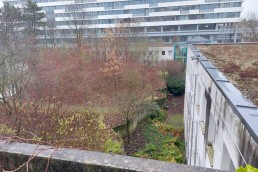
Image of spontaneous urban nature at the Ruhr-University Bochum © S.Stiehm
The future of centres is inclusive, green and productive!
The future of centres is
inclusive, green and
productive!
How do you bring more quality of stay into the city centre, how more culture and identity? This year’s Kulturkonferenz Ruhr in Herne addressed this question with an extensive programme. At the invitation of the Regionalverband Ruhr, lala.ruhr contributed a workshop – the title of which also referred to our approach: The future of the centres is inclusive, green and productive!
We were able to win over three organisations from our network to examine Herne’s inner city with us from different perspectives: The Dortmunder Urbanisten e.V. (speaker: Annette Bathen) addressed the idea of productive inner cities. The group from kitev (Oberhausen, speaker: Petra Jablonická) dealt with green stations as special transit spaces. “Gemeinsam für Stadtwandel” (Essen, speaker: Martina Nies) focused on the collaborative city. All three presented their perspectives on the city in short inputs before a tour together with the participants of the cultural conference – cultural workers as well as representatives from administration and urban planning – collected concrete ideas and suggestions for the transformation of concrete spaces in the city centre.
During the tours, exemplary ideas for transformation were discussed in concrete terms and recorded photographically – the basis for our memory maps of the potential places in Herne’s inner city.
One example: the car park on Cranger Straße as a busy main street: during the excursion it became clear that it is empty for most of the day and is only used during “rush hour” in the afternoon when parents pick up their children from the adjacent primary school. The idea that emerged during the tour: with simple means such as plants, the square could be quickly, effectively and clearly separated from the main road. Some of the hardly used parking spaces could be replaced by benches and a bike (repair) café with music could be placed there during the midday rush hour to encourage parents and children to cycle to school and spend time together in the new green oasis.
This idea is exemplary for many of the impressions, photos and visions that were discussed in the final round: to be implemented with simple means, commitment and cooperation. In addition to concrete results on site, this also promotes a process culture that involves different actors and empowers them to shape the inner city as a place worth living in. All participants in the workshop agreed that the multitude of exemplary approaches found in all three tours can also be used in your daily work with cities.
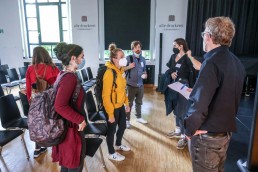
Impression from the workshop for lala.ruhr at the Kulturkonferenz Herne. Photo: RVR / Oberhäuser
Imagine Green Urban Futures at Places Festival 2021
Review:
Imagine Green
Urban Futures
Imagine Green Urban Futures: This was the motto of lala.ruhr’s programme at the Places VR Festival. Because: We need images for the future of our urban landscapes. Conventional plans and illustrations are difficult for many people to grasp. Extended Reality, on the other hand, makes visions come alive and vivid, as became clear in the programme around Bochumer Straße in Gelsenkirchen.
Three teams created their augmented reality applications especially for the festival, in which they each designed a section of Bochumer Straße – a 120-year-old street in Ückendorf – in a green and visionary way: Via smartphone and tablet, the festival visitors were able to see for themselves how powerful these impulses are when they are not only transported via paper, but become four-dimensional and thus come to life.
The respective offices, or protagonists, had previously qualified through a competition and pursued different approaches:
The respective offices, or protagonists, had previously qualified through a competition and pursued different approaches:
Anja Cambria Oellermann, scenographer from Hamburg, placed the discovery of urban nature and the curiosity of visitors at the centre of her vision for Bergmannplatz, including nature islands, a wildflower field and a small pond.
The Cologne-based firm Greenbox Landschaftsarchitekten invited visitors to discover the “Green Canyon” and transformed the street, which is dominated by car traffic, into a lively spatial installation that can be used on several levels, including details such as integrated photovoltaic elements and a charging infrastructure for e-cars.
The Berlin agency pimento formate focused on edutainment for sustainability and combined elements such as virtual palm trees, flowers and bubbling fountains with information on suitability under aspects of climate neutrality.
In a fourth section along Bochumer Straße, the visitors could become active themselves and not only provide greenery, but also wish for elephants, zebras and sofas.
In the courtyard of the Quartieroase, visitors followed impulses and panels on digitality in planning on both days. In the adjacent garages, which were transformed into lounges with the help of sofas, carpets and the like, our technology partner for the implementation of AR applications, the Aachen-based start-up Cityscaper, as well as pimento formate with the project “futureleafmission” and the team from Greenymizer with their vision of an app for more digital participation in the Green City of the future presented themselves – a very special reunion, as the team had formed at the hackathon at the Places Festival 2020 and won two awards with a prototype. In addition, a video loop in the Garage Lounge offered the opportunity to get to know other innovative XR projects.
The programme was complemented by a poster exhibition, through which the following international projects and offices were presented with references to the respective project pages:
- AVP (Düsseldorf): Presentation of complex real estate projects in virtual animation.
- Anja Cambria Oellermann & Shaouhan Hu: Ensō – Analysis of the Boundary
between water and land in Japanese temples and in the urban space of Kiel. - Form Follows You GmbH (Berlin): Digital Participation Bahnhofstraße Lichtenrade
- Green4Cities (Vienna): Developing Urban Green Visions
- Greenymizer: Vision of the app “City Greenymizer” for citizen participation
- Dr. Nadina Galle (Amsterdam): “Internet of Nature” for building smart green cities
- Jan Kamensky (Hamburg): Utopia for Bicyclists – Utopian animations
- LAND (Milan/Lugana/Düsseldorf: CariGO GREEN3 – Digital Landscape. Programme for the territorial development of the landscape Gorizia on the border between Italy and Slovenia
- pimento formate (Berlin): Futureleaf – AR-Mission on microplastics in the city
- Katie Patrick (San Francisco): Can Gamification save the planet?
“Imagine Green Urban Futures” was made possible by a grant from the E.ON Foundation and cityscaper, our technology partner for the development of the AR applications.
Sincere thanks also go to our speakers:
Stephan Muschick (E.ON Foundation), Stefanie Hugot (Head of the Department of Urban Planning at the City of Gelsenkirchen), Dr. Volker Settgast (Fraunhofer Austria), Hilke Berger and Immanuel Schipper (HafenCity University Hamburg), Matthias Funk (scape Landschaftsarchitekten GmbH), Burkhard Drescher (Innovation City Management GmbH), Prof. Dr. Ismeni Walter (University of Applied Sciences Hamburg), Prof. Dr. Ismeni Walter (University of Applied Sciences Hamburg). Dr. Ismeni Walter (Ansbach University of Applied Sciences) & Michelle Adolfs (Team Greenymizer VR), Elle Langer and Markus Mende (pimento formate), BIMa.solutions – Virtual Reality for Architecture, Sebastian Witt, Juliane Ebeling and Robin Römer (Cityscaper Aachen).
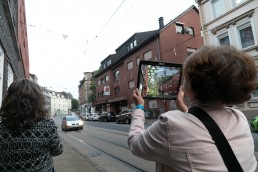
Imagine Green Urban Futures – a visitor uses the AR applications. Photo: Places _ VR Festival/Ole-Kristian Heyer
polis AWARD 2021 for lala.ruhr in communicative urban design
polis award:
3rd place for
lala.ruhr
The lala.ruhr team is delighted about the polis award: we won 3rd place in the category “Communicative Urban Design”, which honours instruments that involve people creatively and at eye level in urban development processes.
1st place went to the online public participation process for the urban open space planning competition “Am Alten Güterbahnhof” in Duisburg, 2nd place to the audio walk of the model project “Rathausblock” in Berlin. Congratulations to all nominees and award winners, also in the other categories!
The polis award of the polis Magazine for Urban Development is presented annually in various categories to projects in urban development and the real estate industry that are based on a spirit of partnership in the development of solutions for the city of the future.
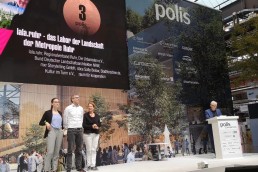
Presentation of the award to lala.ruhr at the polis Convention 2021 in Düsseldorf.
Our contribution to the Places VR-Festival - XR in urban planning!
Our contribution to the Places VR-Festival - XR in urban planning!
Under the motto “Imagine Urban Green Futures”, lala.ruhr invites you to discover the inner courtyard and the visionary garage workshops: We will present digital innovations in spatial planning with images, videos and animations, and in the garages you can meet the technology partners, programmers and artists at work. The green courtyard and its garages will be transformed into an inspiring green lounge for two days.
Opening on September 17th at 14.00 o’clock in the courtyard of Bochumer Straße 110 in 45886 Gelsenkirchen!
The project “Imagine green urban futures” is funded by the E.ON Foundation. Together, we want to test the concrete use of augmented reality in urban planning in order to give new impulses for participation and citizen involvement – so that the city of the future can be experienced and the debate about it becomes lively.
How do we want to develop our cities for the future? lala.ruhr invites you to the Quartiersoase and presents lots of inspiration around digital tools and interventions for planning and participation.
- Talk and exhibition on VR and AR in urban and landscape planning and for participation formats in urban development.
- Introduction to the AR project “Imagine Green Urban Futures” along Bochumer Straße
- Meet the artists
- Showrooms and workshops for digital planning tools
On-site participants include: Stephan Muschick (E.ON Foundation), Stefanie Hugot (Head of the Urban Planning Department at the City of Gelsenkirchen), Dr. Volker Settgast (Fraunhofer Austria), Hilke Berger and Immanuel Schipper (HafenCity University Hamburg), Matthias Funk (scape Landschaftsarchitekten GmbH), Burkhard Drescher (Innovation City Management), Prof. Dr. Ismeni Walter (Ansbach University of Applied Sciences) & Michelle Adolfs (Team Greenymizer VR), Jan Kamensky (Hamburg), Elle Langer and Markus Mende (pimento formate), BIMa.solutions – Virtual Reality for Architecture, Sebastian Witt & Robin Römer (Cityscaper Aachen)…
Friday, September 17, 2021
Opening hours 14 – 20
Saturday, September 18, 2021,
Opening hours 10 – 18 h
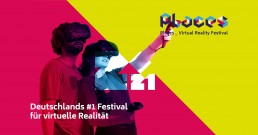
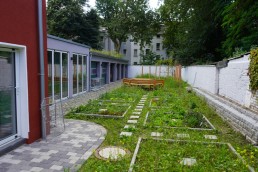
The Quartiersoase, in the backyard of Bochumer Straße 110 is one of the many extraordinary locations of the Places _ VR festival.
Imagine green urban futures: the teams have been selected!
Imagine green urban futures: the teams have been selected!
The participants in the “Imagine green urban futures” competition, which was looking for technology-savvy planners and designers, have now been selected: the teams of lala.ruhr and the Places _ VR Festival are pleased to welcome the agency pimento formate, the landscape architecture firm GREENBOX and the scenographer Anja Cambria Oellermann to Gelsenkirchen-Ückendorf.
The jury, consisting of Sebastian Schlecht (lala.ruhr), Daniela Berglehn (EON.Stiftung) and Thomas Dietrich (Chairman of bdla NRW), decided in its digital session on the three applicants from a large number of submissions, each of whom brought exciting and different approaches to the task of developing a green and sustainable vision for Bochumer Straße based on 3D data.
The Berlin agency pimento formate, with its team led by managing director Elle Langer, wants to focus on edutainment for sustainability and playfully inspire people to articulate their ideas for green house facades, locations for urban gardening and the like and to record them with the help of self-shot augmented reality stories (AR).
The team from the Cologne office Greenbox Landschaftsarchitekten, led by Felix Brennecke, applied with the idea of thinking urban planning vertically with the help of an AR application and thus using the street or urban space on several levels.
Anja Cambria Oellermann, a scenographer from Hamburg, wants to use AR to promote the discovery of the environment, for example by showing changes in the city’s nature when it rains.
The three selected participants now have one month to realise their respective visions in 3D before cityscaper, the project’s technology partner, converts the data into AR applications. Visitors to the Places Places _ VR Festival (17 & 18.09.2021 in Gelsenkirchen-Ückendorf) can then explore the results via smartphone or tablet.
The project “Imagine green urban futures” is funded by the E.ON Foundation. Together, we want to test the concrete use of augmented reality in urban planning in order to give new impulses for participation and citizen involvement – so that the city of the future can be experienced and the debate about it becomes lively.
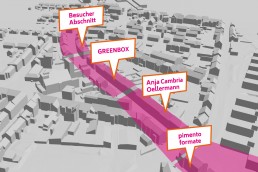
Division of Bochumer Straße
Green Infrastructure Offensive: Handing over the recommendations for action to the RVR
green infrastructure offensive:
handover of
recommendations for action
to the RVR
The time has come: The team of lala.ruhr, commissioned by and in cooperation with the Regionalverband Ruhr (RVR), has developed a strategic-conceptual contribution as a building block for the communication offensive Green Infrastructure of the RVR in a process lasting several months. This has now been handed over to Nina Frense (Councillor for the Environment and Green Infrastructure). In essence, the aim was to develop proposals and to win over actors from different areas for cooperation.
The results of the “Festival of Landscape”, which reached over 200 participants in digital space in February, as well as interviews with innovative landscape and urban designers, people involved in non-institutional planning contexts and artistic perspectives were incorporated. Hints and approaches for goal-oriented communication and the involvement of actors in the design of green infrastructure in the Metropole Ruhr were compiled and described in the present recommendations for action, which can serve as a basis for the regional joint project of designing and communicating a sustainable urban landscape.
lala.ruhr would like to thank all those who contributed their expertise – whether as interviewees or participants in the Festival of Landscape or participants of the digital festival formats!
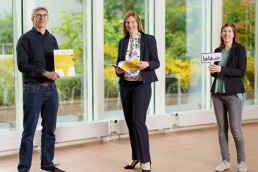
Handover of the recommendations for action to Nina Frense (Deputy for the Environment and Green Infrastructure of the Ruhr Regional Association, RVR, centre) by the lala.ruhr initiators Sebastian Schlecht (left) and Melanie Kemner (right). Photo: RVR/Volker Wiciok
Podcast tip: the one minute city and the Internet of nature!
Podcast tip:
the one minute city
and the
internet of nature!
At the lala.ruhr festival in February this year, there was a very special live session that was recorded and has now been released as an English-language podcast: The one minute city and the internet of nature! It is an episode of the Urban Landscape Lab podcast with Tommaso Bassetti, expert in urban and climate policy, which provides a platform for discussing experiences, innovative ideas and projects at the intersection of urban quality of life, green performance and quality.
As a result of the pandemic, we have had and continue to have less or no access to offices, bars, restaurants, museums and open spaces. Never before has urban quality of life been so dependent on the spaces that lie outside our doors. Together with Dr. Nadina Galle, ecological engineer and pioneer of the concept “Internet of Nature”, and Andrea Balestrini, director of LAND Research Lab, we explored during the festival how ordinary urban streets can be redesigned to benefit their inhabitants even after the pandemic, while increasing resilience to an accelerating climate crisis through green performance.
If you missed the session during our festival, you can now listen in here:
#thinklandscape
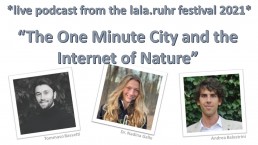
Apply: Imagine green urban futures - lala.ruhr goes places!
Apply:
Imagine green urban future
- lala.ruhr goes places!
Are you a tech-savvy (landscape) architect, urban planner, designer or innovator?
Then lala.ruhr in cooperation with the Places_Virtual Reality Festival in Gelsenkirchen-Ückendorf has a very special challenge for you, namely the competition “Imagine Green Urban Futures”!
What is it about? The task: You develop a green and sustainable vision for Bochumer Straße – a 120-year-old street in Ückendorf, based on existing 3D data. The 3D models will then be converted into real AR applications by our technology partner cityscaper and can be explored by visitors to the Places _ VR Festival (17 & 18.09.2021) via smartphone or tablet.
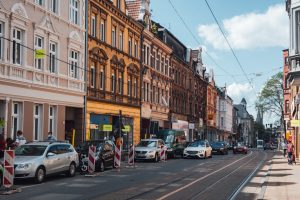
The process:
- You submit your application with the selected street section of Bochumer Straße by 11 July.
- A jury of experts will select three participants/teams.
- You will receive an allowance of 1,000€ and work on your vision for one month.
- Visitors to the Places _ VR Festival can experience your vision live in augmented reality on 17 & 18 September 2021.
The Places _ Virtual Reality Festival is Germany’s first, largest, freely accessible and free festival for virtual reality. In 2021, the festival will enter its third round. The Places _ VR Festival is aimed equally at a professional audience, but especially at a broad public audience, and has been taking place in Gelsenkirchen-Ückendorf since 2018. Places is a meeting place for the German and European XR industry as well as a contact point for many people interested in VR.
The project is realised together with cityscaper as a technology partner and the e.on Foundation as a sponsor. Together we want to test the concrete use of augmented reality in urban planning in order to give new impulses for participation and citizen involvement – so that the city of the future can be experienced and the debate about it becomes lively.
Apply now with your idea, become part of our “Imagine Green Urban Futures” project, work on your vision from mid-July to August and receive 1,000€ expense allowance and implement your 3D model, which visitors to the Places _ VR Festival can then test and experience in AR!
All information and the link to the application form can be found here.
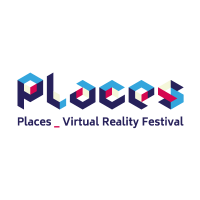
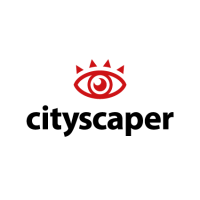
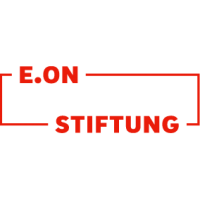
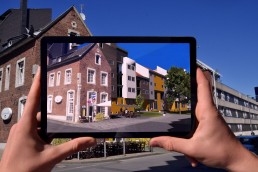
lImagine Green Urban Futures – be part of the Places_Virtual Reality Festival with your vision! Photo: Cityscaper
lala.ruhr - the film: On the road with the actors in the region!
lala.ruhr - the film:
On the road with the actors
in our region!
In order to shape the green city of the future, many perspectives are needed – lala.ruhr has set itself the task of collecting these, promoting exchange and discussing visions and concepts for the future of the Metropole Ruhr. After the participatory festival of the landscape of the Metropole Ruhr, which took place in digital space in February, we have been on the road in Essen, Gelsenkirchen and Oberhausen in recent weeks to visit innovative projects and capture exciting voices and faces.
With the support of the Regionalverband Ruhr and three protagonists, the result is a 12-minute film from a variety of perspectives. What is the job of landscape architects? Have you ever heard of organism democracy? And what happens on the roof of the Oberhausen Job Centre? You can find the answers in the film! We are looking forward to your feedback!
#thinklandscape!
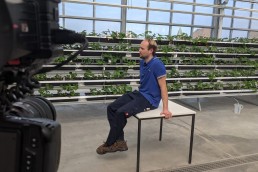
In order to shape the green city of the future, many perspectives are needed – three of them are captured in our new film.
Workshop report: Urban gardening in the Ruhr area
workshop report: Urban gardening
in the
Ruhr area
More community gardens in the Ruhr area – how does that work? Jonas Runte and Nils Rehkop recently explored this question in a digital workshop organised by lala.ruhr. As members of the Dortmund Urbanists, they can report from years of practical experience in the implementation of community gardens.
Public, communal and voluntary – these are the core elements of the definition of urban gardens. More than 100 urban gardens and about 1600 allotment gardens exist in NRW. In the city in the form of community gardens, school gardens, guerrilla gardening and “edible city” areas, close to the city as rented fields or areas for solidarity agriculture. The facilities serve a variety of aspects: in addition to environmental protection and the strengthening of biodiversity, social aspects in particular are in the foreground. Gardening together promotes, among other things, encounters and exchange, identification with the neighbourhood, and saves money through the aspect of self-sufficiency.
However, it is not enough to “put a garden in front of people’s doors”. According to the urbanists’ experience, it is much more important to build up a motivated group that is willing to get its hands dirty. Not only with soil, but also with the sometimes exhausting filling out of papers. Nevertheless: gardening together in the Ruhr area is possible and it is fun, so the conclusion. If you are interested in the various examples from Dortmund and the surrounding area as well as information on funding opportunities, you can find the presentation on the workshop here: Urbane-Gärten-im-Ruhrgebiet-die-Urbanisten
Text: Jonas Runte/Sonja Broy
Foto: die Urbanisten e.V.
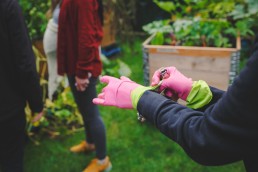
The urbanists are active in Dortmund’s Westgarten, among other places.
green-blue streets: planning task at the rwth aachen
green-blue streets:
planning task at the
rwth aachen
green-blue streets: Water-sensitive city Essen-Altendorf. This is the title of a planning task of the Chair of Landscape Architecture at RWTH Aachen University, which was co-developed by lala.ruhr. The project involves the development of a neighbourhood model for liveable, green-blue streets, its elaboration for a street and square space as well as another open space of one’s own choice in the neighbourhood.
The background to the task in the current summer semester: our cities must become more water-sensitive. Under the conditions of climate change, green and blue infrastructure play an increasingly important role in coping with extreme climatic events. In the area of water, this means that public and private open spaces must buffer heavy rainfall events as well as remain attractive during longer dry periods. A gradual conversion is also necessary in the existing city. In addition to the classic green open spaces such as gardens and parks, streets and squares should also be considered for a holistically conceived system of a water-sensitive city. They are the most used public spaces in the city and the capillary vessels of the urban infrastructure, both above and below ground. Liveable streets in a sustainable city should therefore combine many demands: Ensuring traffic and access, absorbing, storing and draining rainwater – at the same time offering residents a beautiful environment and urban flora and fauna a habitat.
The district of Essen-Altendorf, which borders directly on the Niederfeldsee lake, was chosen as an example neighbourhood for the planning task. With the lake and the surrounding areas, a green-blue infrastructure has already been created here, but its integration with the existing city is not yet sufficient. In order to be able to maintain the lake even in dry phases, precipitation water must also be obtained from the neighbouring neighbourhoods in the future. How these can be developed into a blue-green system is being worked out in detail using the example of Weuenstraße and the surrounding area.
We are already looking forward to the students’ designs, which will also be presented here on the blog from the end of July!
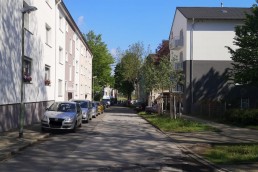
View of Weuenstraße in Essen: Liveable streets in a sustainable city should combine many demands. Photo: Sebastian Schlecht.
workshop report: urban biodiversity
workshop report:
urban
biodiversity
The connection between our actions, the degradation of our ecosystems and the acute loss of biodiversity is obvious. But what role do cities play in this global context? What effects do they have, who do they provide habitats for – and what possibilities do we have to act from cities and enable positive developments? These are questions that lala.ruhr also asks itself time and again, most recently in the context of a workshop during the Metropole Ruhr Landscape Festival.
The terminology
Urban biodiversity as a term refers to the biological diversity of cities themselves. By regional biodiversity flow we mean the influence of human life in the city on the surrounding countryside. Global biodiversity flow refers to our influence on distant countries and their ecosystems – which is drawn from our global consumption patterns.
Biodiversity in planning
In general, it can be said that “nature in the city” is still a fairly young phenomenon in research, which has only been scientifically explored since the 1970s with the emergence of the discipline of urban ecology. While nature and species conservation have a long tradition, little attention has been paid to animals and plants in the city. A weighty reason for this is seen in the long-prevailing separation between human space and nature, reflected in terms such as natural landscape and cultural landscape. In the meantime, planning concepts link spaces and functions – park areas, for example, are no longer defined only as places for recreation, but also with a view to the animal and plant species to be found on them – for lala.ruhr, too, nature already begins on the windowsill.
Biodiversity in the Metropole Ruhr
The Urban Biodiversity Network has been in existence in the Metropole Ruhr since 2012. It brings together important partners who work on the topic of biodiversity and promote a strategy for the Metropole Ruhr. Only a few weeks ago, position papers were published that focus on nine topics: Species and Biotope Protection, Industrial Nature, Urban Agriculture, Urban Forest Use, Open Space and Biotope Connectivity, Climate Change and Climate Adaptation, Urban Greenery and Social Responsibility, Urban Greenery and Health Care, and Environmental Education and Environmental Education Centres.In concrete terms, the Urban Biodiversity Network monitors the species in the Duisburg Landscape Park, for example – an extraordinary diversity with over 700 plant and animal species. An example of this is the 35 different dragonfly species on the grounds of the former industrial site alone.
Biodiversity also plays an important role in the Emschergenossenschaft’s action programme for the development of a climate-silient region through blue-green infrastructures. The necessary solutions for climate adaptation also open up a scope for action. For example, the way a green roof is constructed determines whether insects and birds also find a complementary habitat there.
NABU NRW is also involved in many projects. Thorsten Wiegers emphasised during the festival workshop that biodiversity can be an indicator for liveable cities – not only on the factually necessary level, but also emotionally with enthusiasm. According to a study by the Federal Agency for Nature Conservation, 89% of people in Germany agreed with the statement that “biodiversity in nature promotes their well-being and quality of life”. It is important, especially in the city, that people connect with nature and biodiversity and perceive it as a natural part of their living space.
Another exciting project on the topic of urban biodiversity can be found in Dortmund: Naturfelder Dortmund e.V., embedded in the EU research project “productive Green Infrastructure for post-industrial urban regeneration” (proGIreg), which aims to strengthen the green infrastructure in formerly industrial areas. To this end, the association wants to upgrade areas in Dortmund with the municipality and citizens as flowering meadows with high biodiversity. The first areas were already sown in spring 2021.
Decade of Restoring Our Ecosystems
Together with climate change, the loss of biodiversity is one of the great named crises of our time. Against this background, the UN has declared the Decade of Ecosystem Restoration. Our cities play a major role in this, as they are increasingly evolving from the idea of a medieval bulwark to a real living space for their inhabitants. Animals also see an opportunity here and are migrating to the cities. Exciting in a global context: the work of ICLEI – Local Governments for Sustainability. The organisation’s website provides an overview of biodiversity activities in Europe. There is also a lively international exchange via the platform.
Conclusion of the workshop
The Metropole Ruhr can develop further qualities from its transformation, which are already manifesting themselves in many places that were formerly characterised by heavy industry. However, this will not be the solution to a global crisis. There is still a great need for action to also use urban biodiversity as a basis for a liveable and climate-adapted city, and in doing so to have a positive effect on the global situation – directly through the projects, indirectly through the emerging awareness. In this context, the fragmented structure of the Metropole Ruhr and the current climate adaptation activities offer a potent framework for action that can build on the successful transformation to date: Understanding the Metropole Ruhr as a functioning ecosystem and also shaping it as such.
Text: Sebastian Schlecht
Photo: Bille Helbig
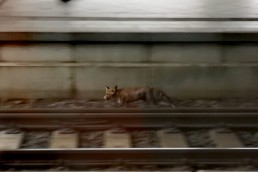
A fox in the middle of a train station: even if we are not always immediately aware of it, our cities provide habitats for animals and plants. Even in places where we don’t suspect it.
New home: Arriving in the urban landscape of the Ruhr region
New home:
Arriving in the
urban landscape
of the Ruhr region
Omar Mohamad compares the urban landscape of Aleppo with that of Mülheim an der Ruhr for lala.ruhr
New home?
2015. The alarm clock rings at 7 am. It is still dark outside. I want to get out of bed, but my mind doesn’t realise that the new day has begun. And I ask myself, has the day already begun? Maybe I am still dreaming? Why is it still dark? I am used a little brightness to start the day. Something in me doesn’t seem to want to understand. Having light in the morning is a feeling of home for me. But my home is 2,936 km away. Deep loneliness overcomes me in the morning silence. In the darkness one is always lonely alone. It is my first winter in Germany. I come from Syria. There, the sun rises at 6:30 a.m (even) in winter. With the first rays of sunshine, people wake up from their dream world and start the new day. But here in Germany, an alarm clock rings. I have to get out of bed and go about my duties. I get up and get ready. I dress warmly, take my bag and leave the gym where I am staying with many others. I am now waiting for the bus. It is cold and dark. I get on the bus and it is still dark. I ask myself: is this a dream or reality? Am I dreaming or is it getting light again? If it remains dark, then I am dreaming. I look out of the window at the houses. They look like the houses of my childhood. Houses I saw in cartoons as a child. To me, all the houses here look the same. I close my eyes and remember the house fronts of my home. I open my eyes. I have finally arrived. I get off the bus and cross the street. Have I really arrived? When does a person actually arrive in Germany? On my way to the language school, I walk through a park and suddenly stop. I look at the lawn. The deep green fascinates me and holds me for a moment. I had never seen such a deep green before. No one who comes from Syria knows such a green. The green of my homeland is a different green and so I wonder if I will ever arrive here. It’s almost light now and it’s clear that everything here is not a dream!
Old home!
Aleppo is a very old city that has been affected by war so it has been destroyed and rebuilt three times. Now it has been destroyed once again. The difference between rich and poor is very big. Here you find a colourful diversity of cultures, ethnicities, and religions. Arabs, Kurds, Arameans, Armenians, Assyrians, Circassians and Turkmen. Many of them are descendants of displaced peoples from the 19th and 20th centuries. Aleppo has become their home. People live close together there and every 100 metres the cityscape changes completely. There are often many more families living in each house than in Germany. The houses in Aleppo generally do not have pitched roofs so you can look out over the city. Every flat has a balcony decorated with plants which is big enough for the whole family to enjoy a coffee in the morning. Like Mulheim, some parts of Aleppo are very mixed but other neighbourhoods are less so and some are homogenous. In any case, the city’s cultural identity is characterised by diversity and tolerance. I miss the vibrant diversity of the pulsating metropolis, the many smells, the good food and, of course, my family and friends. Aleppo is not only the largest industrial city, but also the cultural capital of the country. The city has developed rapidly in the modern age without paying attention to the environment. It has been neglected: residential and industrial areas are mixed together. It was only later on that they thought to establish an industrial area outside the city to improve the quality of life of the city dwellers. This is now located a few kilometres away in the north-eastern part of the city. At the time, I was working in urban development in Aleppo. In the historical development of the city, industry had spread directly into the urban area. A big challenge of my work was to convince the companies that had settled there to use the newly created industrial area.
New ideas for my new home
2021. I get off the bus, finally arrived in Germany. I feel free! No more fear, no more worries! I feel free to express my opinion without being censored, persecuted or tortured. For me, German democracy is like the air I breathe. Now I’m used to the winter darkness and the lush green of the lawn is the green of my new home! But when I walk through the streets, I wonder why they can’t have a car-free city centre, or at least a car-free day. These streets remind me of the streets of Aleppo, which are not very clean either. Aleppo’s streets are no greener than Mülheim’s, but there are very large parks there. There are a lot of concrete buildings at the train station and in Mülheim’s city centre. The Ruhr is a green lung that saves the cityscape. In Aleppo, one Saturday a month, residents and non-residents would clean the streets together. Afterwards, they’d eat, drink and celebrate together. In this way, people from different ethnic backgrounds could come into contact with each other and form friendships. It would be great to establish something like this here in Mülheim as an intercultural initiative.
I continue to ride the Metropolrad to my new job. After completing my training as an event manager at the Ringlokschuppen, I am now an employee at the Theater an der Ruhr. The road is good, but there are still holes and the kerbs don’t make it any easier. Many car drivers show no consideration and claim the road for themselves. A comprehensive extension of the bicycle lanes could be pushed forward. It is difficult to find a safe place to park my bicycle, many parking spaces are occupied by old, forgotten bikes. I still can’t believe it. Some time ago my bicycle was stolen, right in front of the building of the public order office. A parking space with a security system that is insurmountable for the thief. That would be it! I continue on a short passage along the beautiful Ruhr. How quiet and peaceful everything is here. The only thing missing from my dream Mulheim is Mediterranean weather and crystal-clear water!
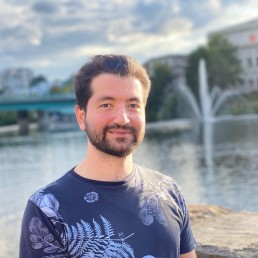
Omar Mohamad (*1989) is interested in intercultural projects and working together. He studied business administration in Syria and trained as an event manager in Germany. Since 2016, he has been volunteering in various projects in the Ruhr area, including the “Free University of Oberhausen”, a socio-cultural education project. He is also a member of the Grün-Bunte list for the integration council of the city of Mülheim. Since September 2020, he has been responsible for PR and audience development at Collective Ma’louba at the Theater an der Ruhr.
Workshop "Urban Gardening" on 6 May!
Register
for the workshop
"Urban Gardening" on 6 May!
Unfortunately, the workshop “Urban Gardening in the Ruhr Area” had to be cancelled during our festival in February due to illness.
We are pleased to announce the date of the workshop:
On Thursday, 6 May from 3 to 5 p.m., Jonas Runte and Nils Rehkop from the Urbanists from Dortmund will present various forms of urban gardening digitally via zoom and give an overview of the scene in the Ruhr region (in German). They will also discuss the hurdles and challenges faced by people who want to garden together in their neighbourhood. Afterwards, suggestions and ideas will be discussed on how to improve the conditions for the creation and long-term existence of these gardens.
Anyone who wants to take part can register free of charge! Registration is open to everyone – regardless of whether or not they are already registered for the original festival date.
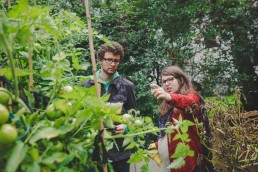
Urban Gardening in the Ruhr are – register now for the 6th of May!
